My early June visit to Great Dixter, the renowned English garden of the late Christopher “Christo” Lloyd (1921-2006), now artfully and creatively managed by his dear friend, fellow iconoclast and head gardener Fergus Garrett, wasn’t on my original itinerary when my London-based eldest son Doug and his partner Tommy treated me to a weekend in Kent. Months earlier, I had asked them if it would be possible to visit Sissinghurst prior to my joining Portland-based Carex Tours the following week to visit gardens such as Dan Pearson’s Hillside, Malverleys, Yews Farm (you can click on the links to see my blogs on those lovely places), Oudolf Field and others. We stayed in a lovely Airbnb in the pastoral countryside near Biddenden, enjoyed a wine-tasting of Kent’s sparkling white wines at Balfour Winery and zipped around the narrow, hedge-lined byways in our rental car. But on our Sissinghurst morning, I realized how close we’d be to Dixter (just 11 miles into neighbouring East Sussex) and asked if there might be time to squeeze in a late afternoon visit between lunch and our dinner reservation. I had last visited Great Dixter 31 years earlier when Doug was studying at Cambridge but much had changed in that time.
So that is how on June 4th – without benefit of the highly recommended garden map, below…..
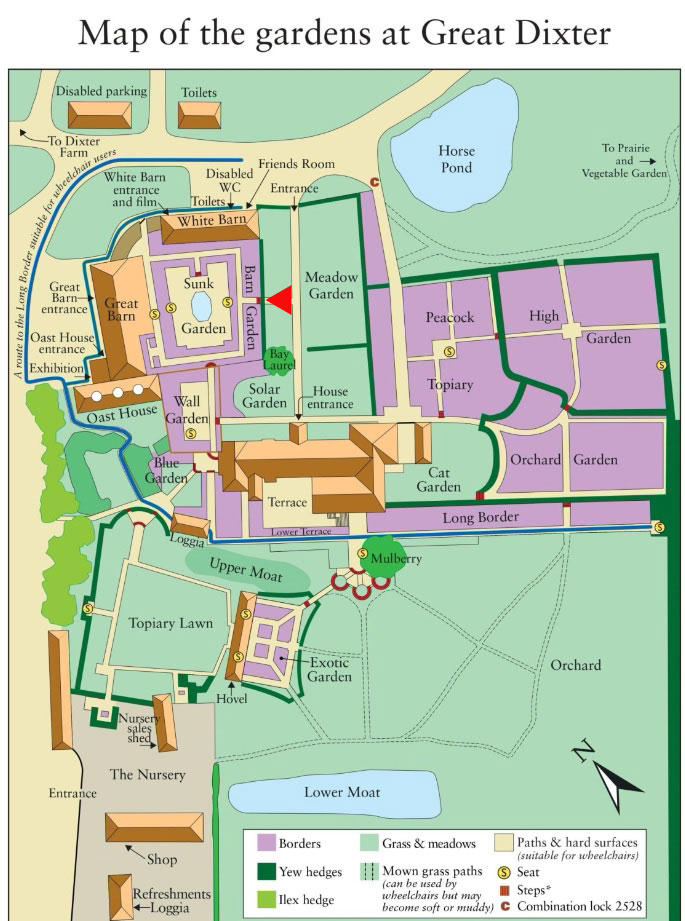
….or prior research, or even physical orientation on a frightfully sunny afternoon (the photographer’s curse, apologies in advance) – I found myself walking into the colourful profusion of the Barn Garden (the red arrow on the map above shows my entrance), with the 500-year old Great Barn directly ahead. Restored in 2012, it is now used for ‘green’ woodworking, rural crafts, and to house the boiler that heats the manor house. What I didn’t realize upon entering was that my view across to the Great Barn was actually over a lower central pool terrace with its own planting, called the Sunk Garden. But up here, the effect was of a classic English cottage garden, all tumble and charm, yet very carefully managed and edited throughout the season.
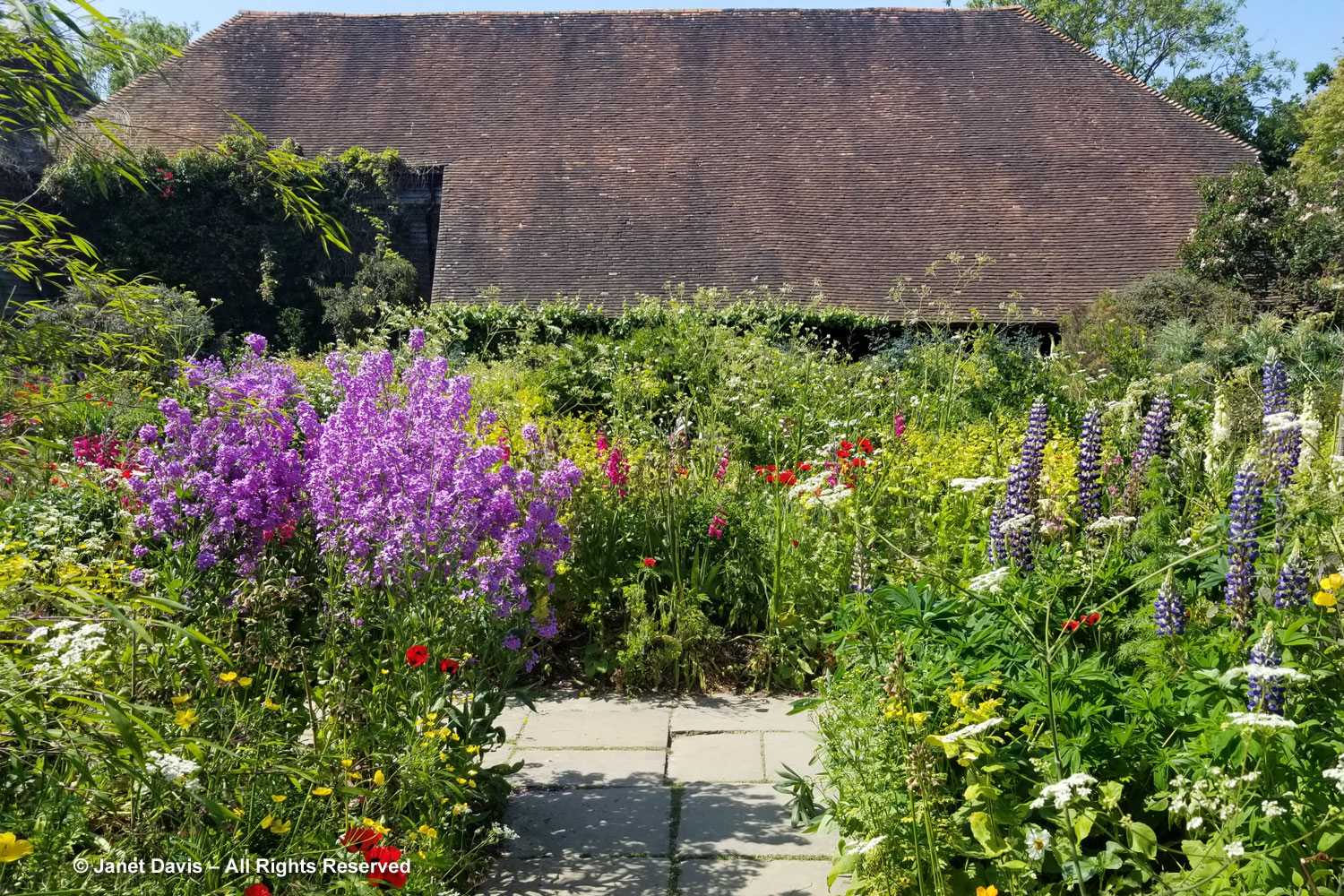
As I turned right, I walked towards the White Barn (you can see the juxtaposition of the two barns on the map above) with its espaliered fig tree on the wall. Flanking the path and cascading over it were white cow parsley (Anthriscus sylvestris), mauve sweet rocket (Hesperis matronalis), magenta Byzantine gladiolus (G. communis subsp. byzantinus), buttercups, daisies, lupines, foxgloves, alliums and poppies.
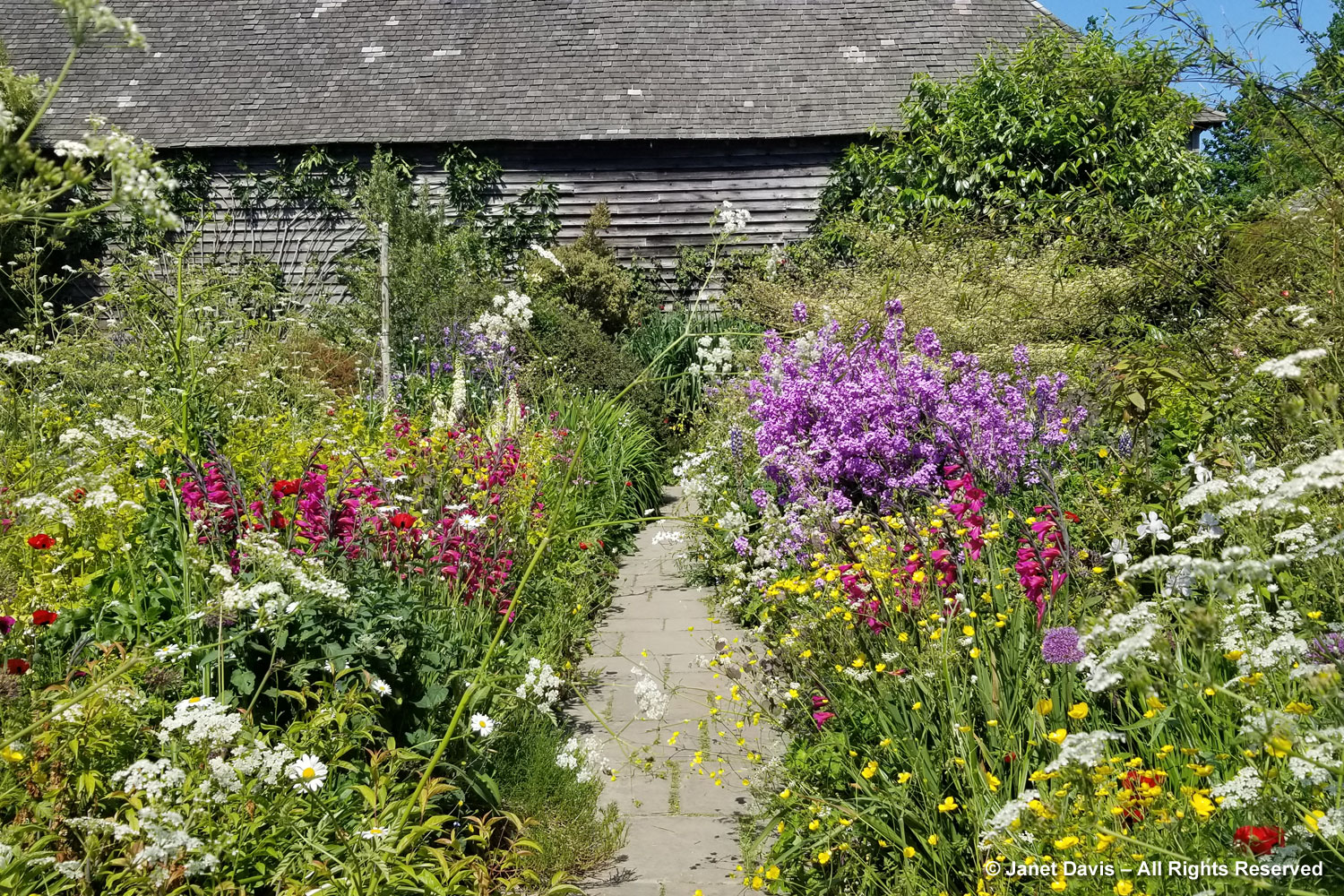
In the garden alongside the barn, I was treated to an eye-popping display of spring-blooming yellow alexanders (Smyrnium perfoliatum) punctuated with Byzantine gladiolus. Yellow alexanders has become popular in recent years as a brilliant foil to late tulips and early summer perennials and bulbs; a monocarpic plant, it takes two or three years to flower, then dies. At Dixter, its black seeds are carefully harvested as the finished plants are removed to be grown on as seedlings for the garden or to the nursery shop.
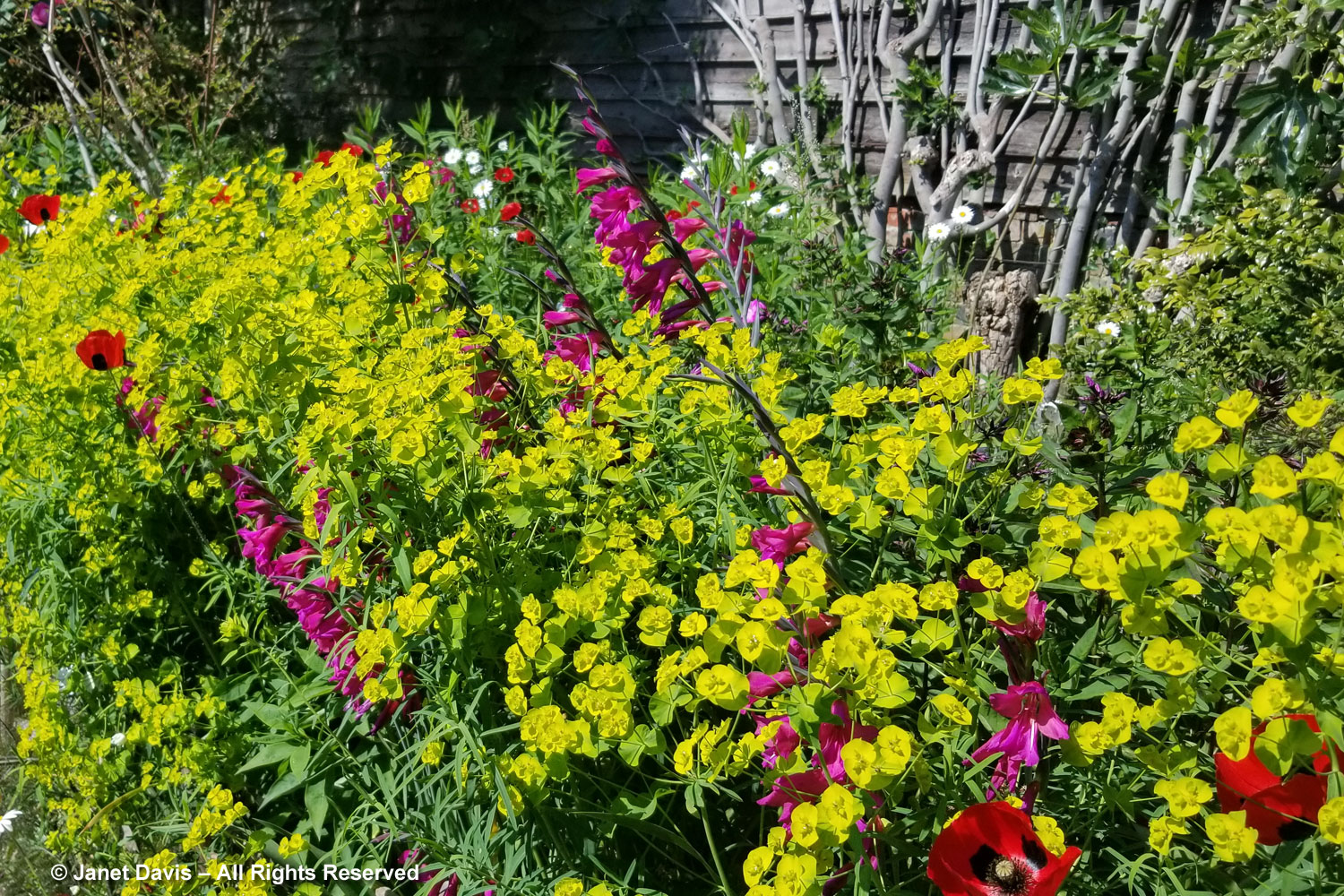
Further on, the scarlet ladybird poppies (Papaver commutatum) held their own nicely against the acid-chartreuse of the yellow alexanders.
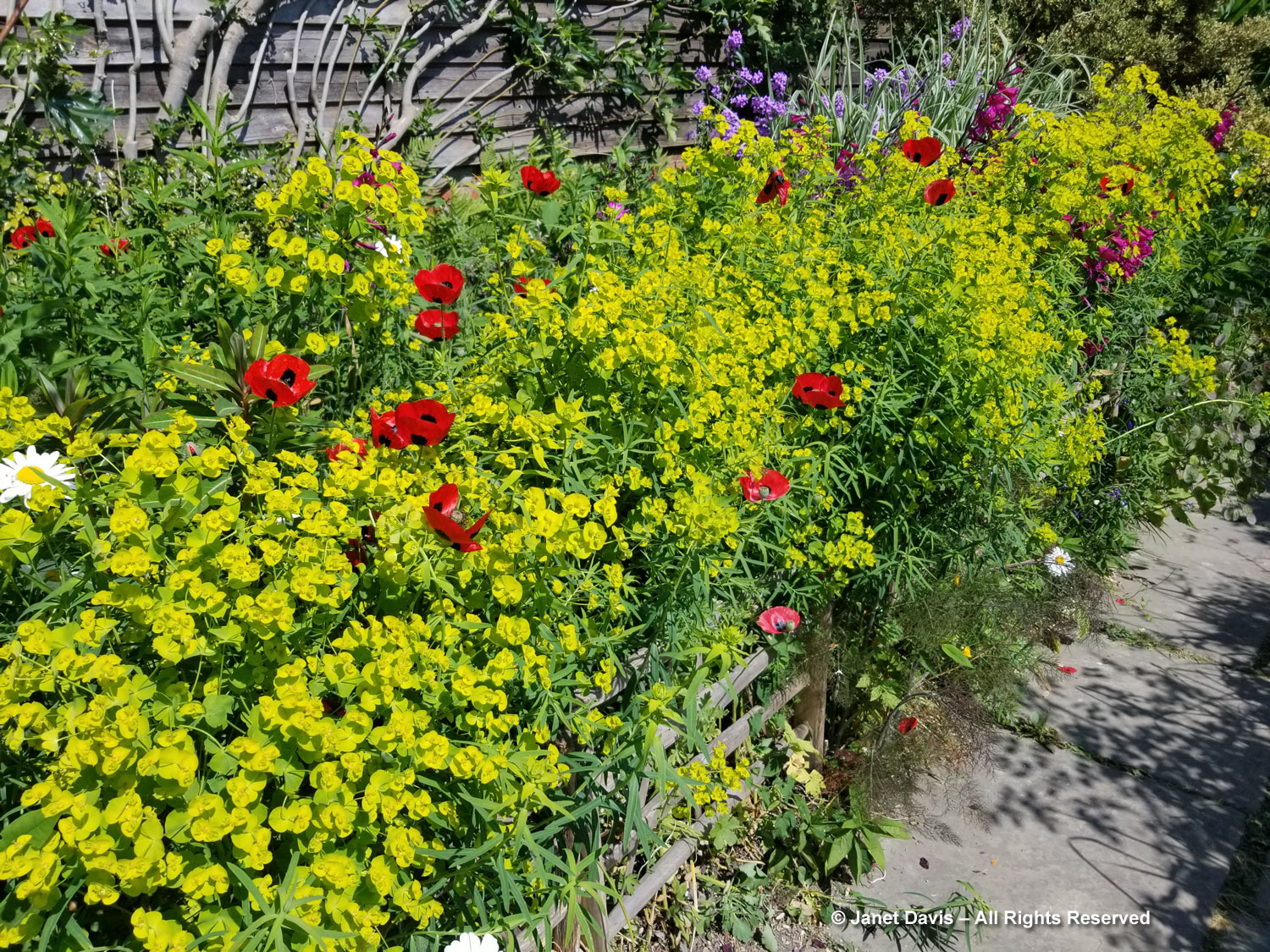
This lovely poppy with its prominent black blotches seems to have more presence than its cousin, the corn poppy (Papaver rhoeas). I have photographed it paired beautifully with Orlaya grandiflora in the Gravel Garden at Chanticleer.
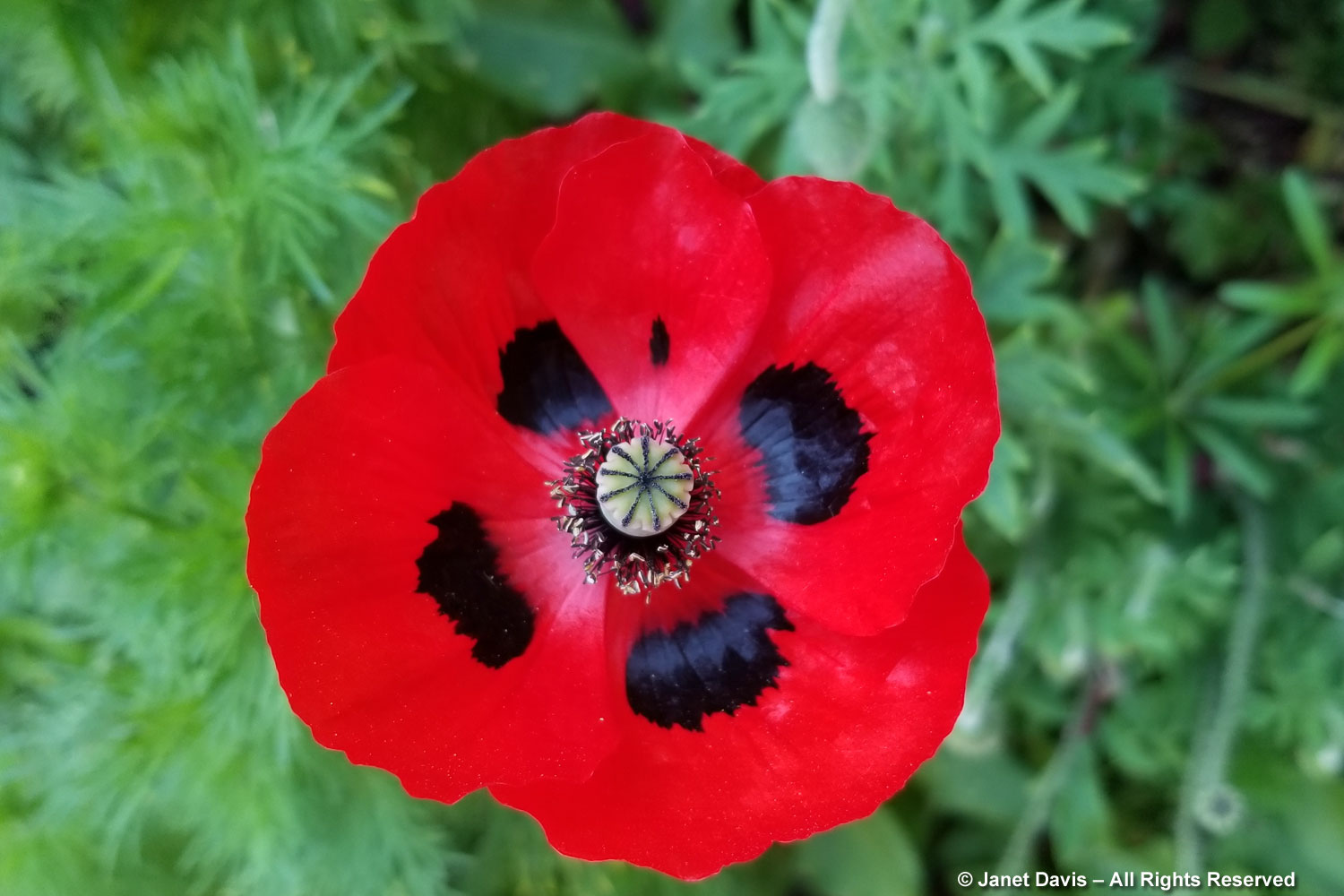
Giant fennel (Ferula communis) grows in the Barn Garden, its towering scapes a blast of Mediterranean sunshine. Fergus Garrett gifted some of his plants to Dan Pearson, whose Somerset garden Hillside I blogged about recently.
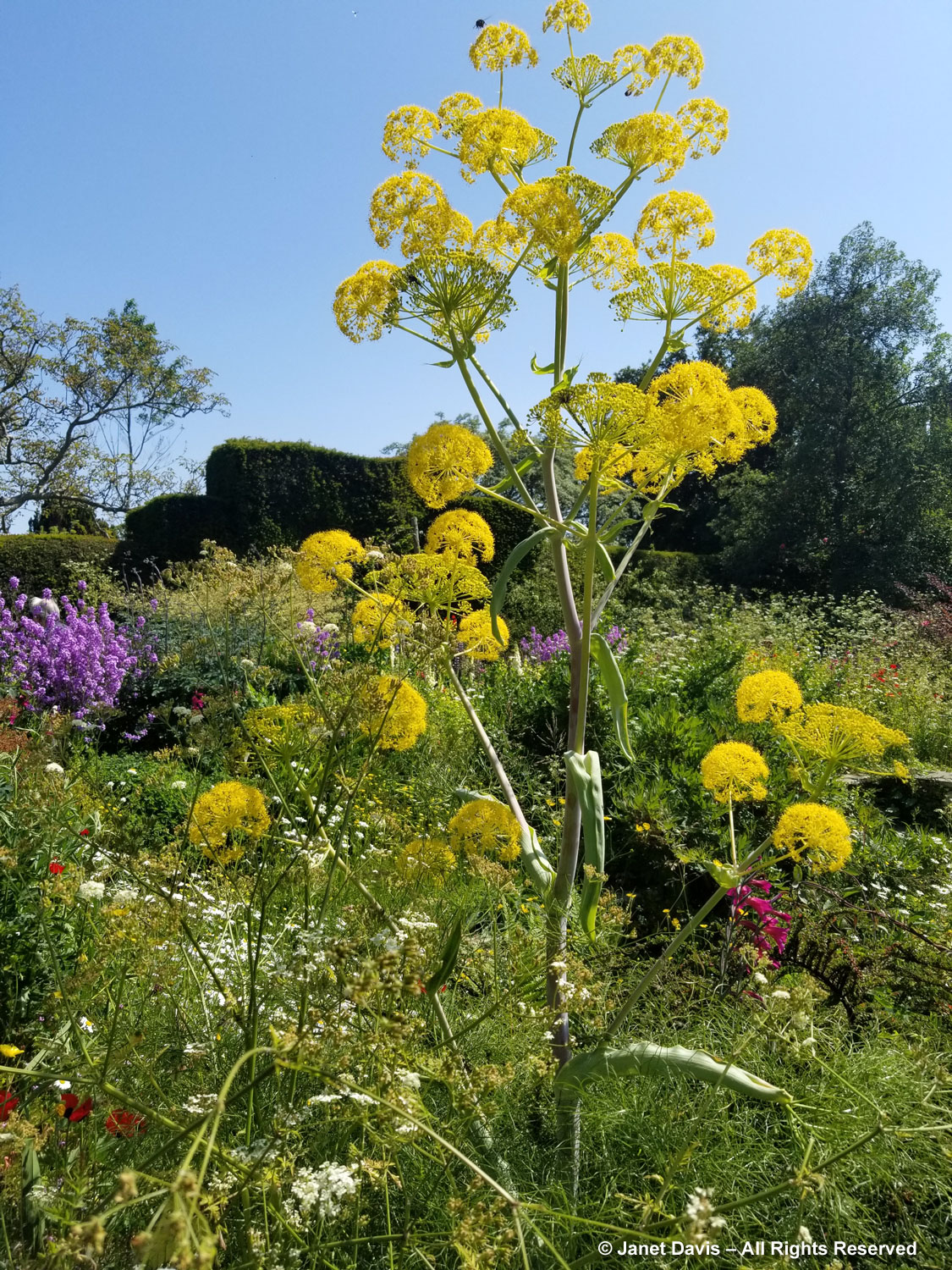
Mixed in are late spring garden favourites like peony.
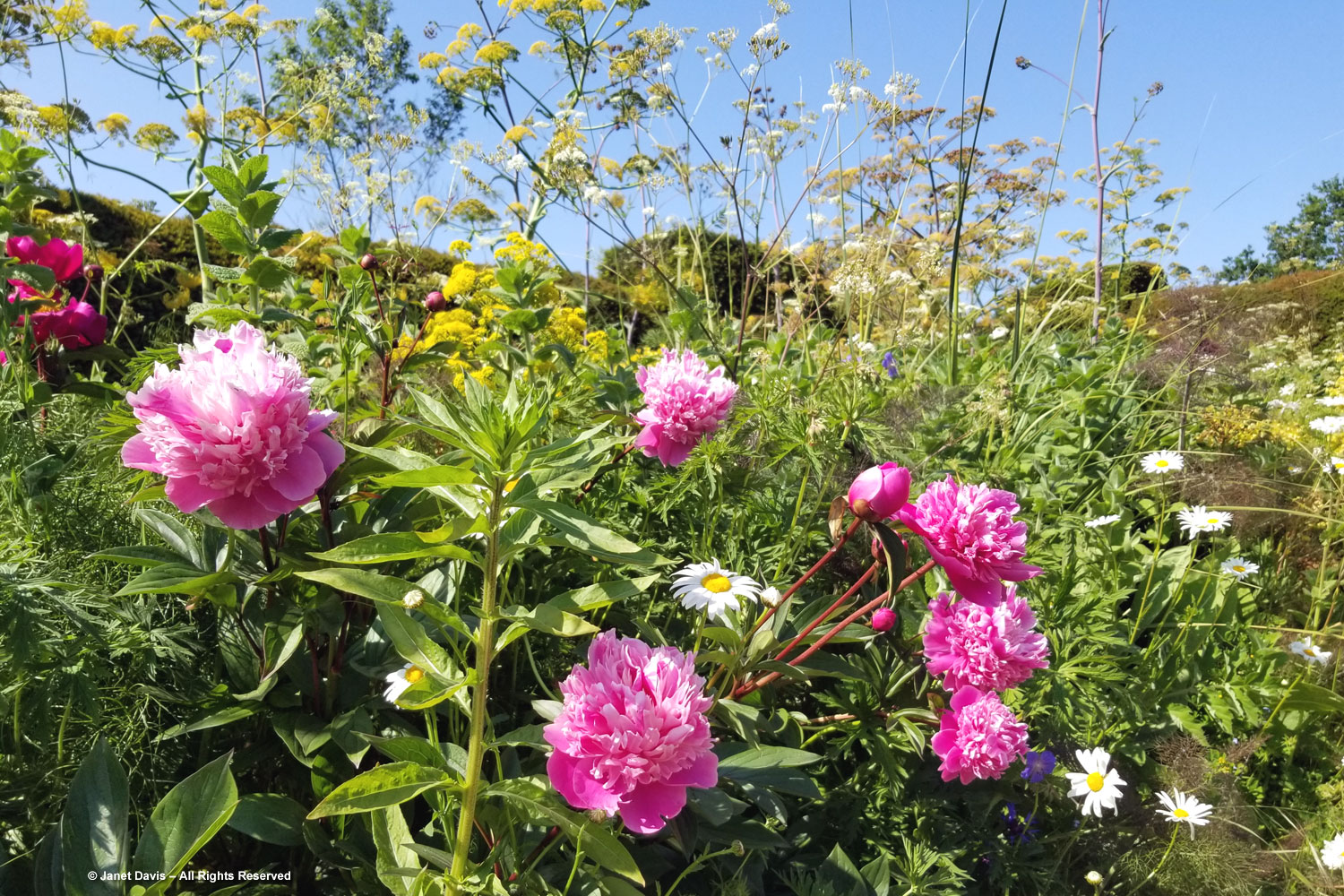
I circled the Barn Garden until I was looking across the Sunk Garden at the White Barn through Ladybird poppies and yellow Baptisia. Here you can clearly see the arrangement of the garden, as well as the espaliered ‘Brunswick’ fig (Ficus carica) on the White Barn wall. Wrote Christopher Lloyd: “The fig trees against the far barn wall were a Lutyens touch which you meet on other properties where he worked. They are there for foliage effect and he used the many-fingered Brunswick fig as being one of the most decorative.” Sir Edwin Luytens, of course, was the renowned architect who renovated Great Dixter and designed some of the gardens for Christopher’s father and mother Nathaniel and Daisy Lloyd when they purchased the property in 1910.
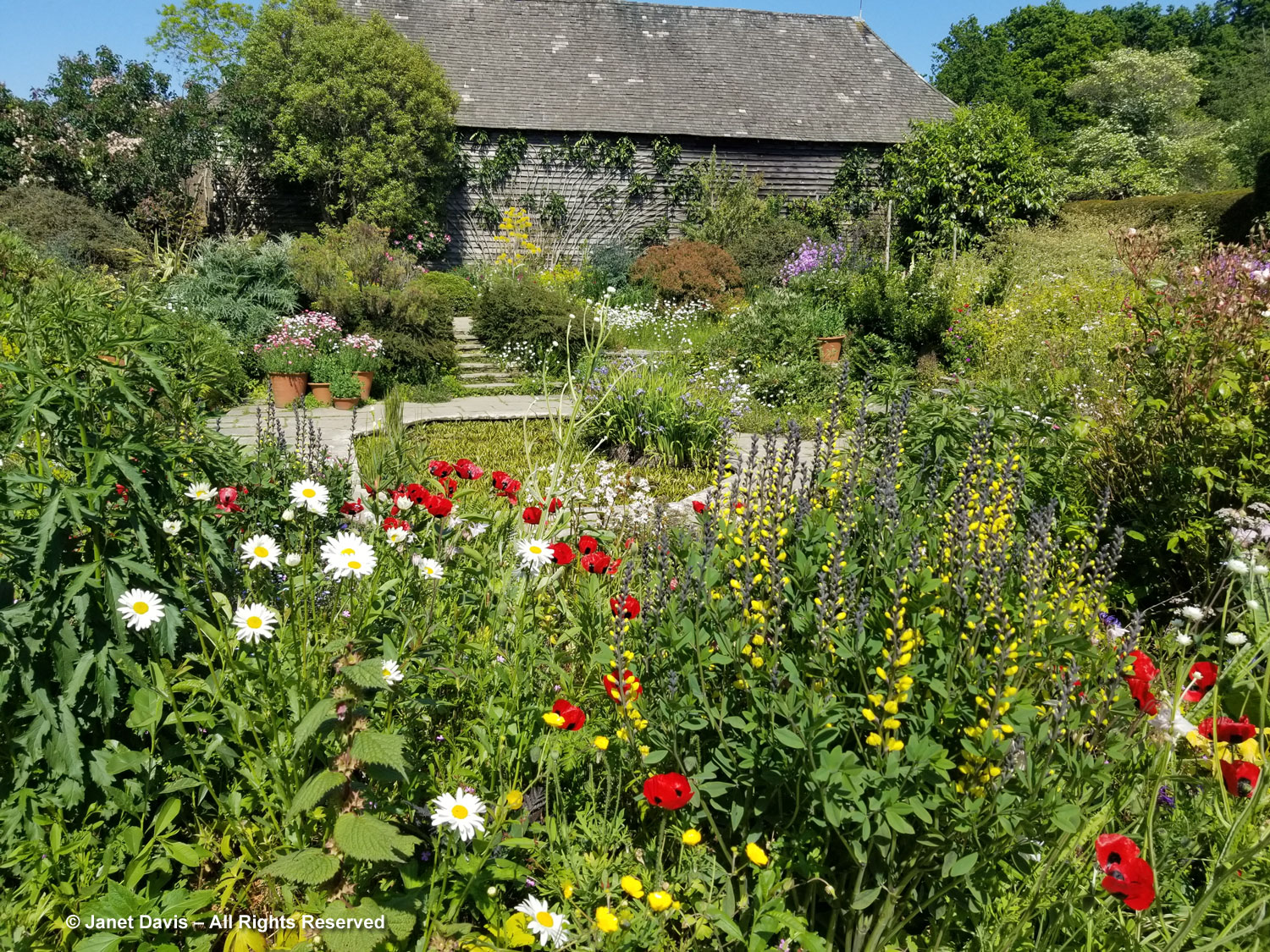
The Sunk Garden was originally a lawn; during the First World War, it was turned into a vegetable garden. After the war, this octagonal pool was created…..
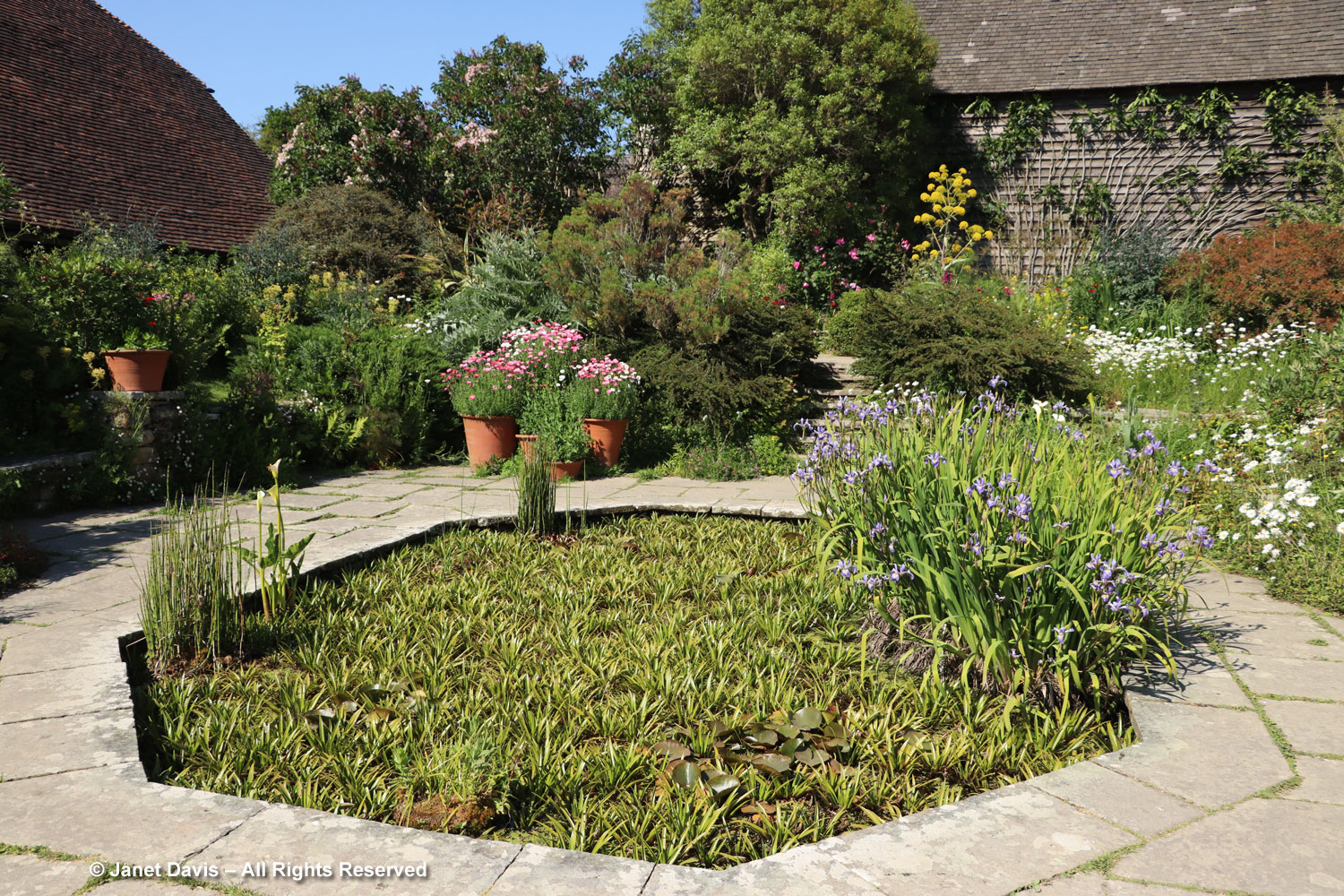
… in which grew a pretty combination of Siberian iris (Iris sibirica) and calla lily (Zantedeschia aethiopica).
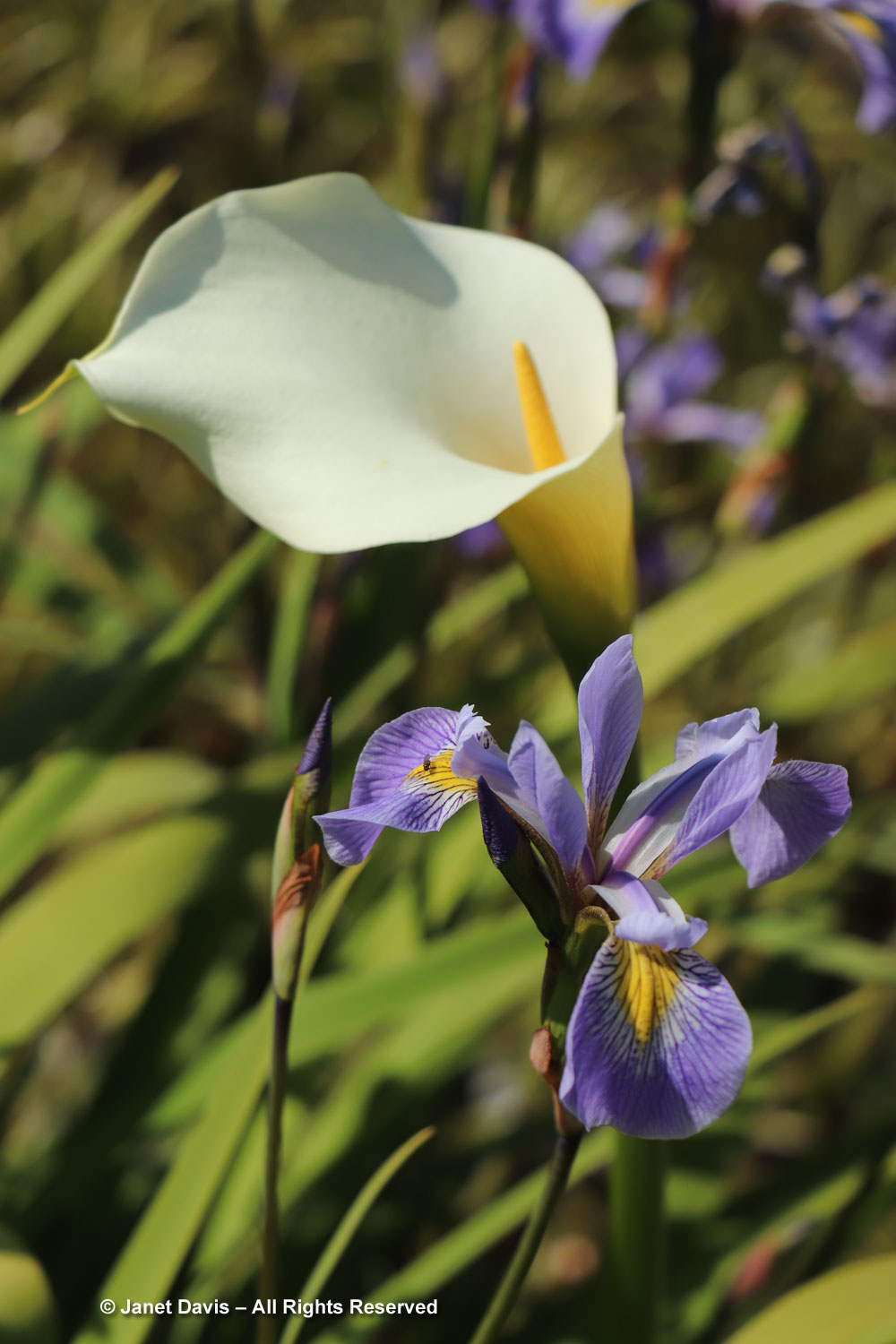
The stone ledges in the Sunk Garden, featuring tiny Mexican daisy (Erigeron karvinskianus), were as artfully wild as the plantings above.
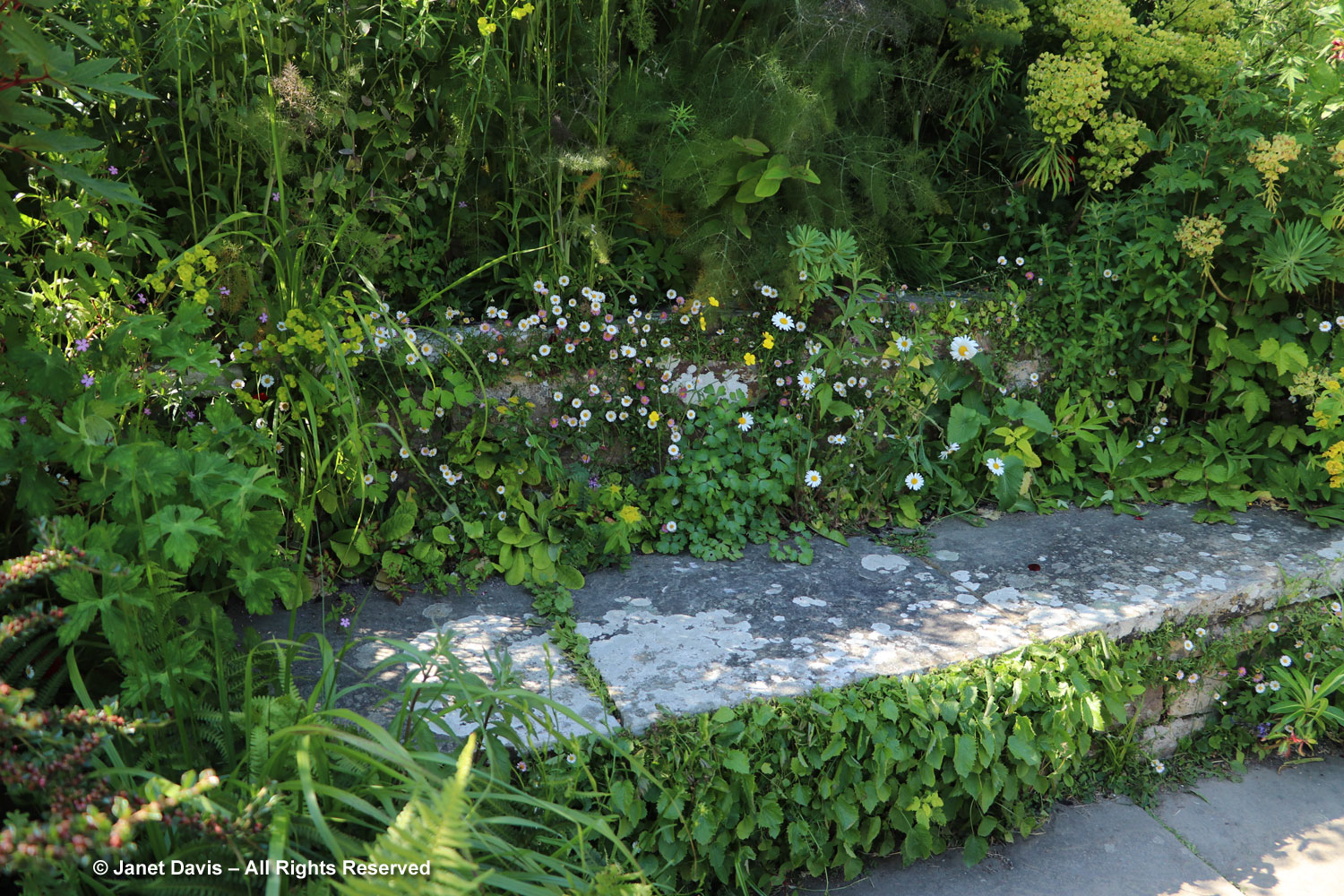
Leaving the Barn Garden I entered the Wall Garden. Here, hot oranges, golds and reds played off the colour of the bricks in the wall.
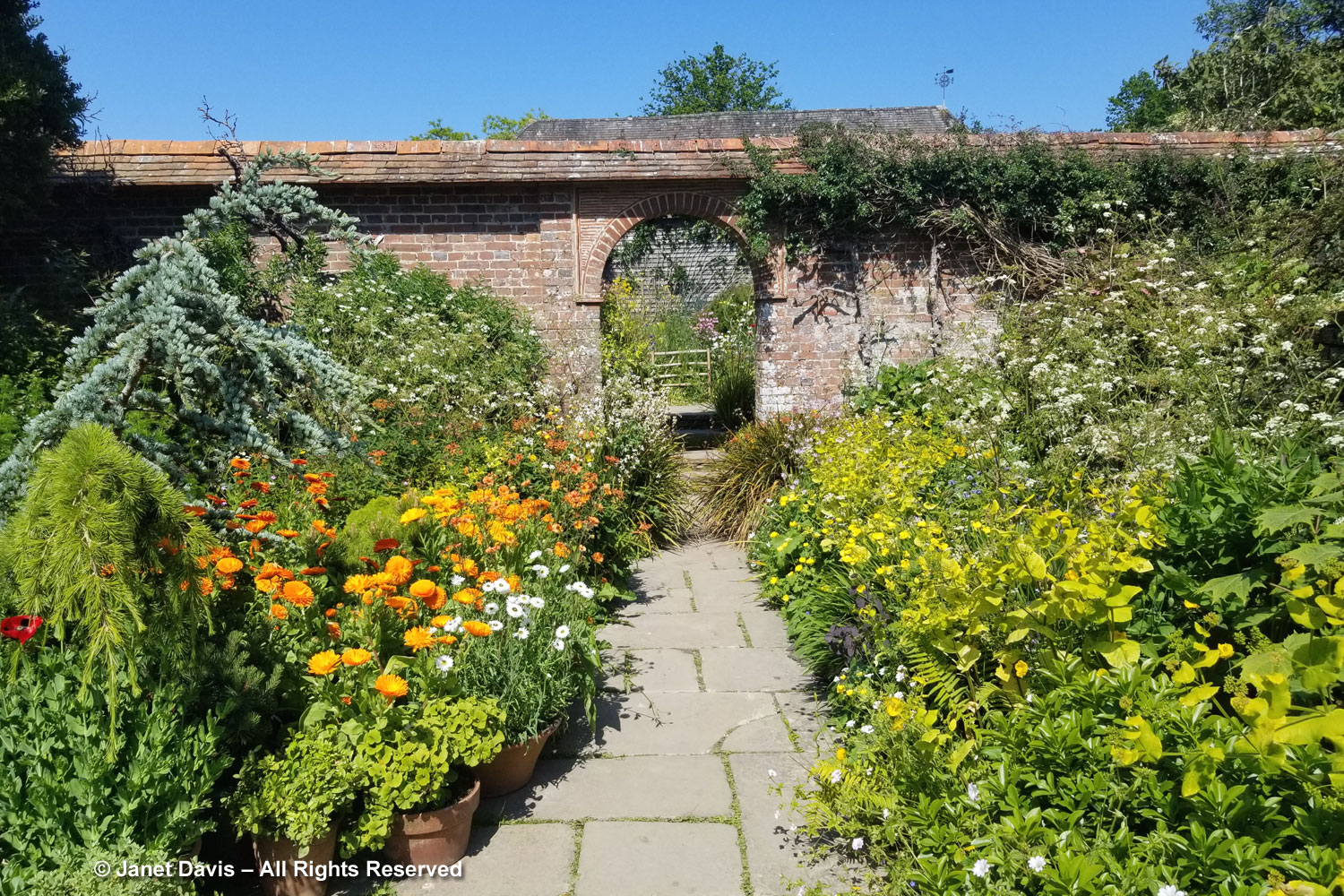
One of the horticultural legacies of Christopher Lloyd’s career is the introduction of a popular spurge called Euphorbia griffithii ‘Dixter’. I’m not sure if this is that cultivar, but it’s a good orange touch.
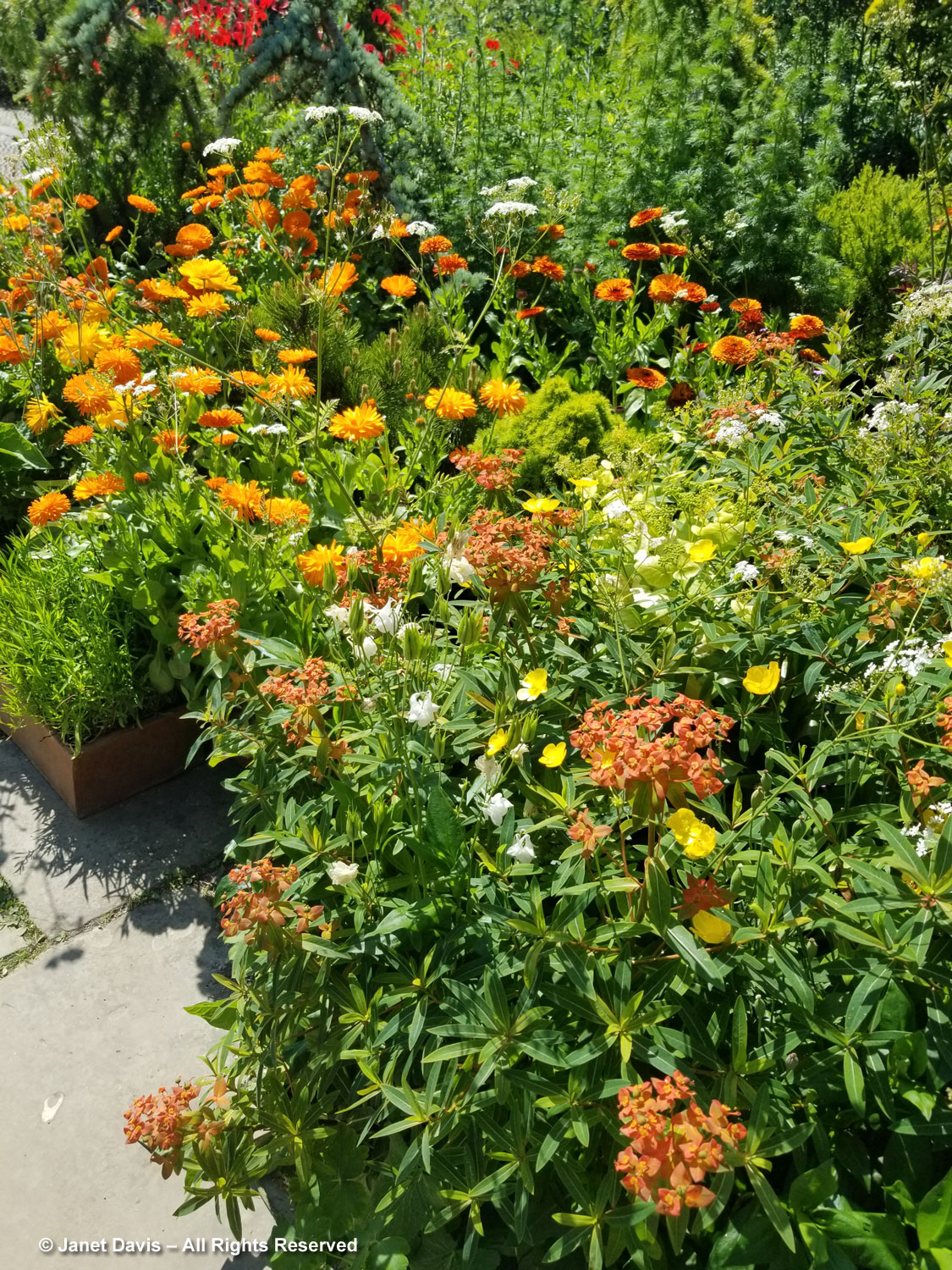
It’s not all blazing colour in the gardens; there are wonderful, small vignettes in shade that offer a little visual stillness, like this one featuring striped lily-of-the-valley (Convallaria majalis ‘Albostriata’).
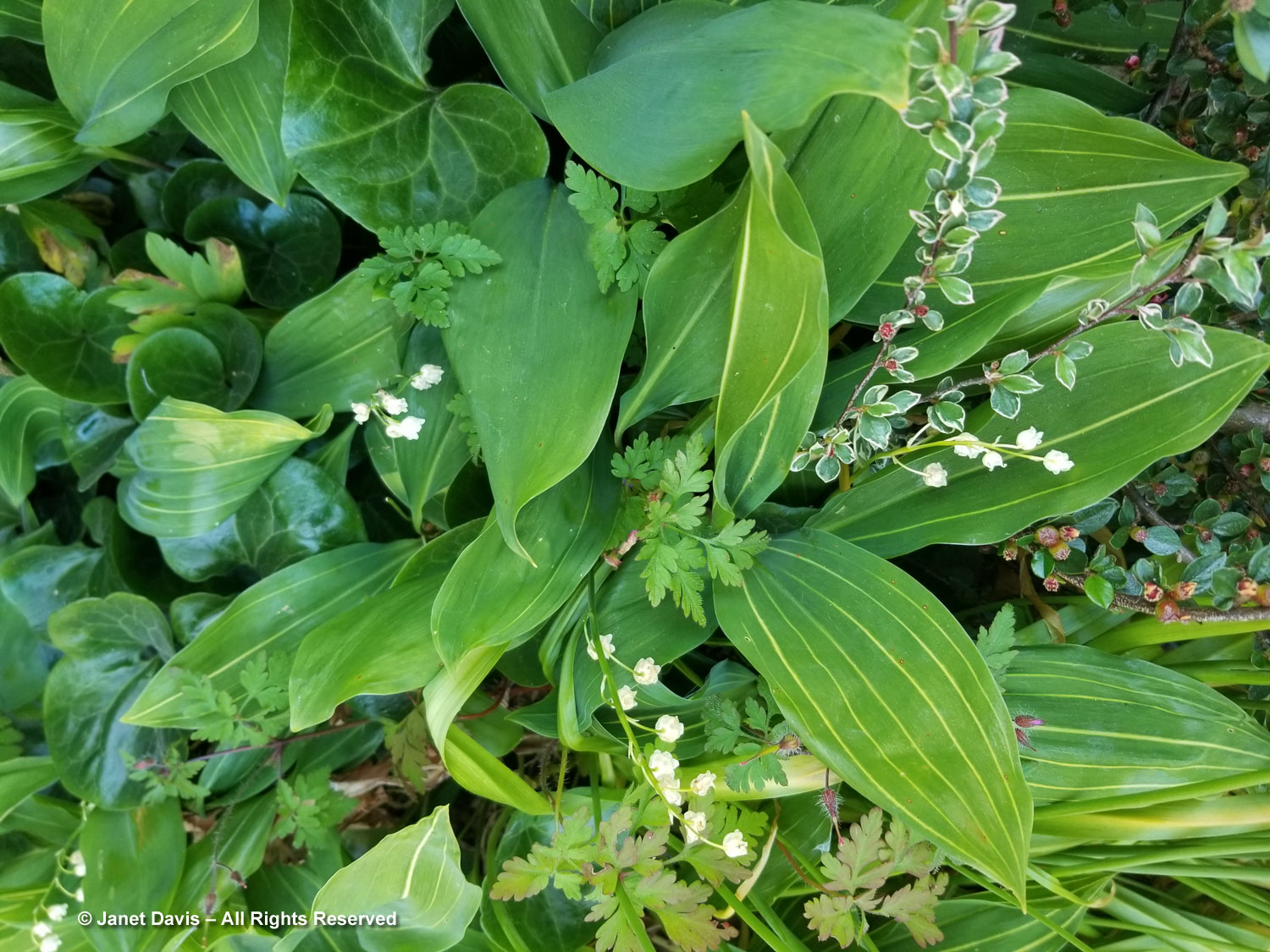
And some perennials stand aloof from the crowd, like Thalictrum aquilegolium.
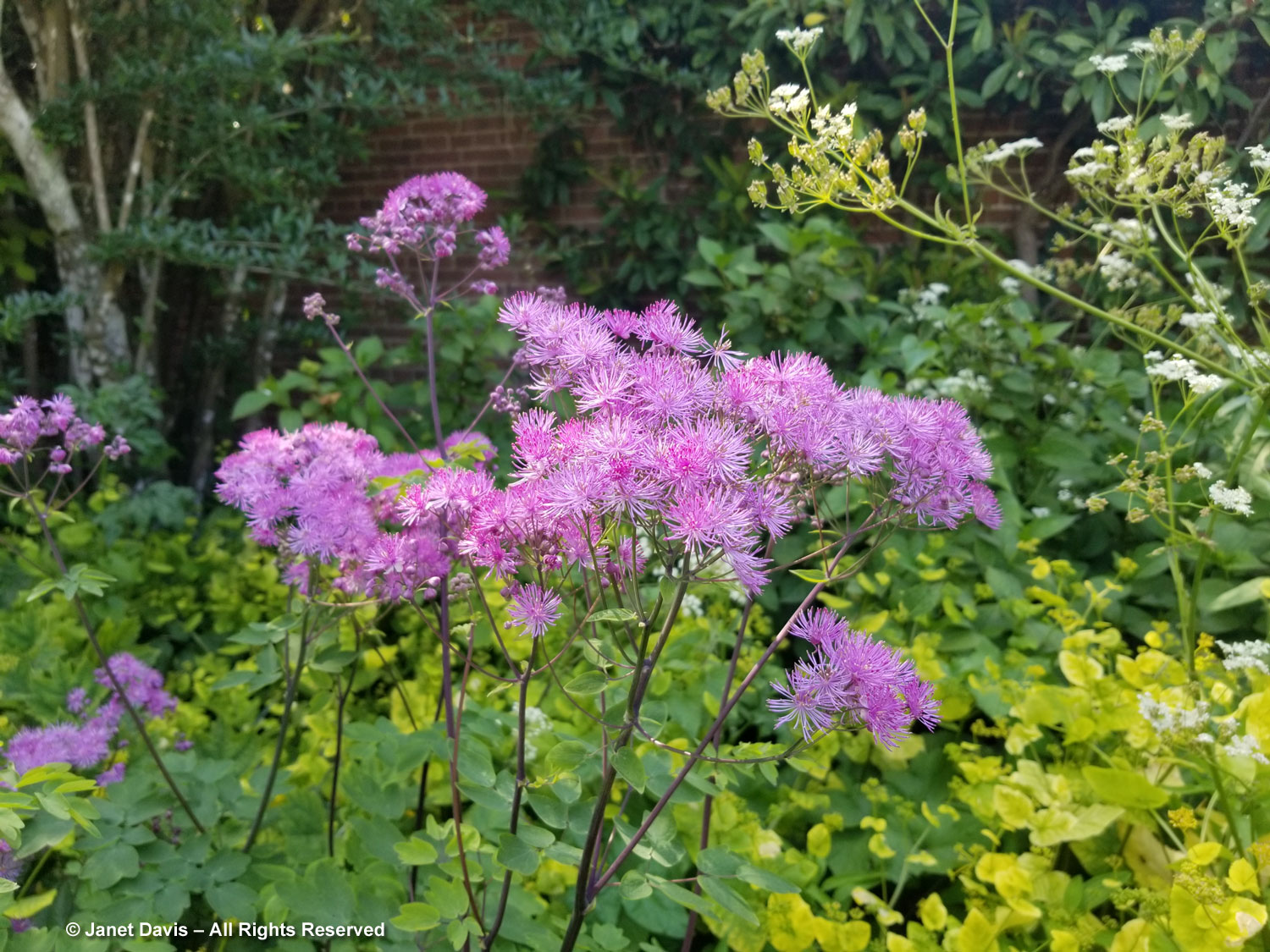
As I left the Wall Garden, I got a little lost. The scene below with its pretty white partners – Allium stipitatum ‘Mount Everest’, Orlaya grandiflora and oxeye daisy – might have been in the Peacock Garden; then again, perhaps the Blue Garden. With such a short time to visit, I just kept moving.
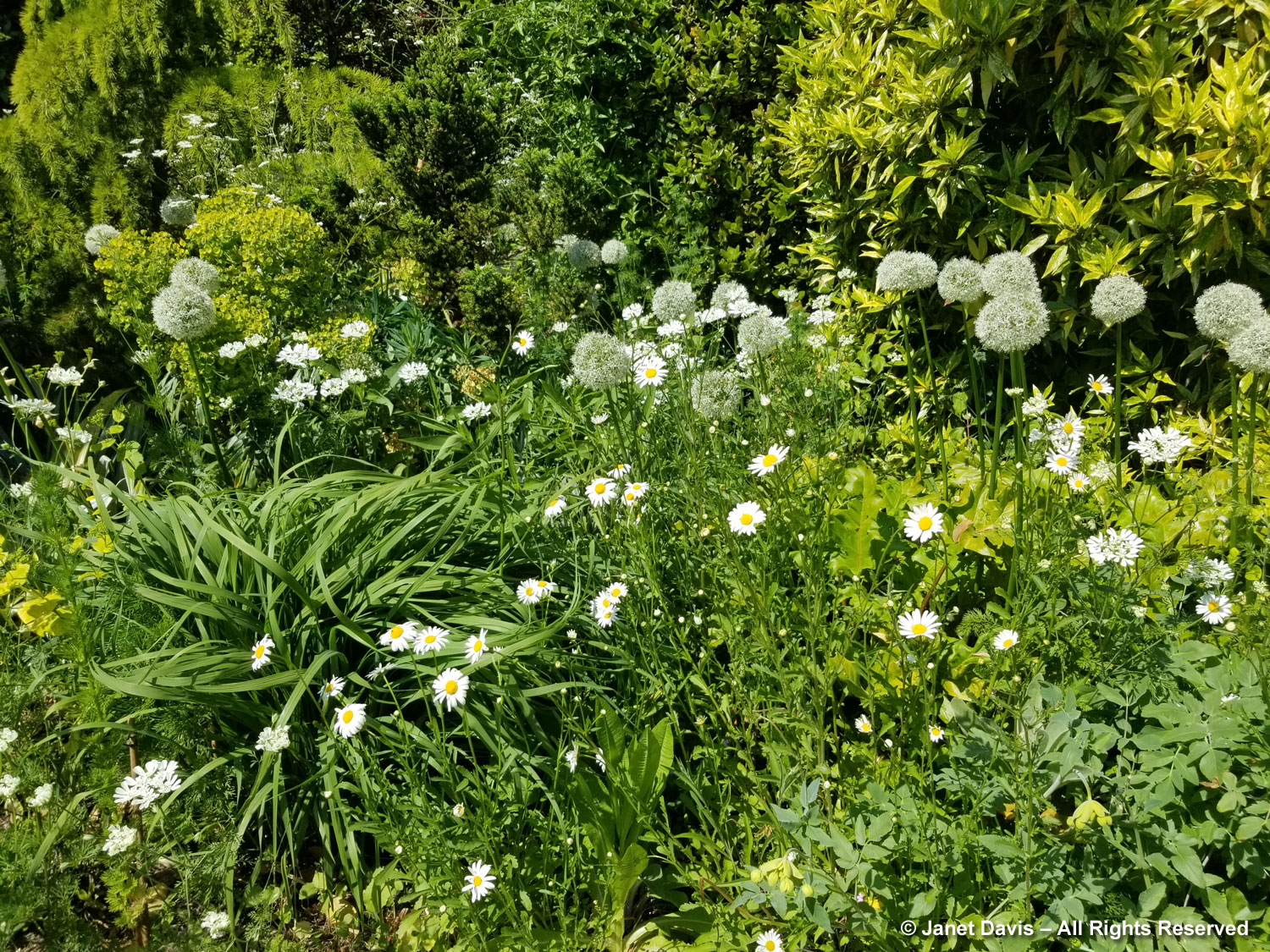
Here you see native cow parsley (Anthriscus sylvestris) rising above all. It was in bloom wherever we drove throughout the Kent and Sussex countryside and Fergus Garrett uses it judiciously in the gardens for its airy effect, being careful to pull it before it goes to seed.
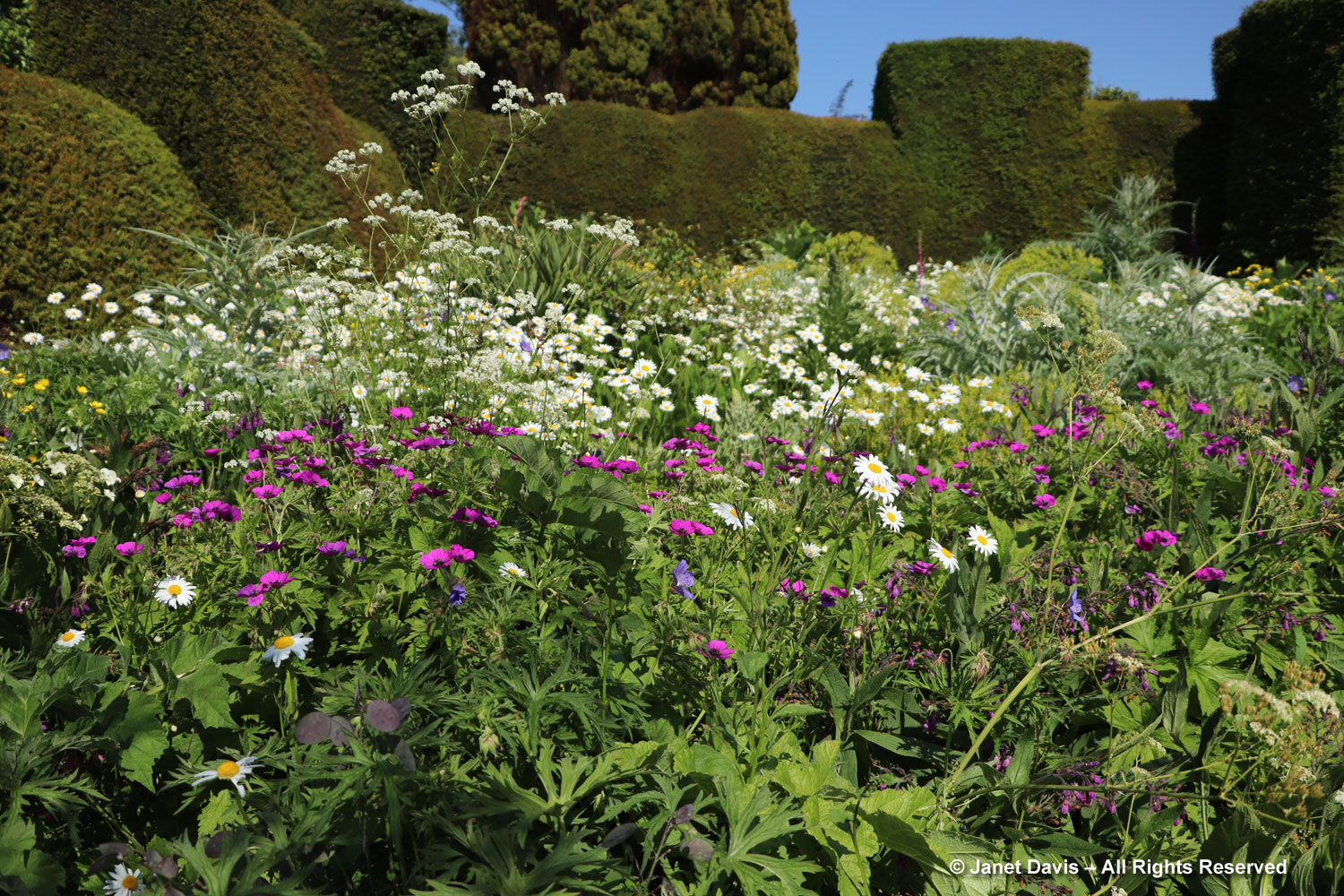
Biennial dyer’s woad (Isatis tinctoria) — a plant Fergus Garrett calls “much underestimated” — is also used for its great cloud of sulphur-yellow flowers in late spring. Here it partners with blue false indigo (Baptisia australis) and oxeye daisies.
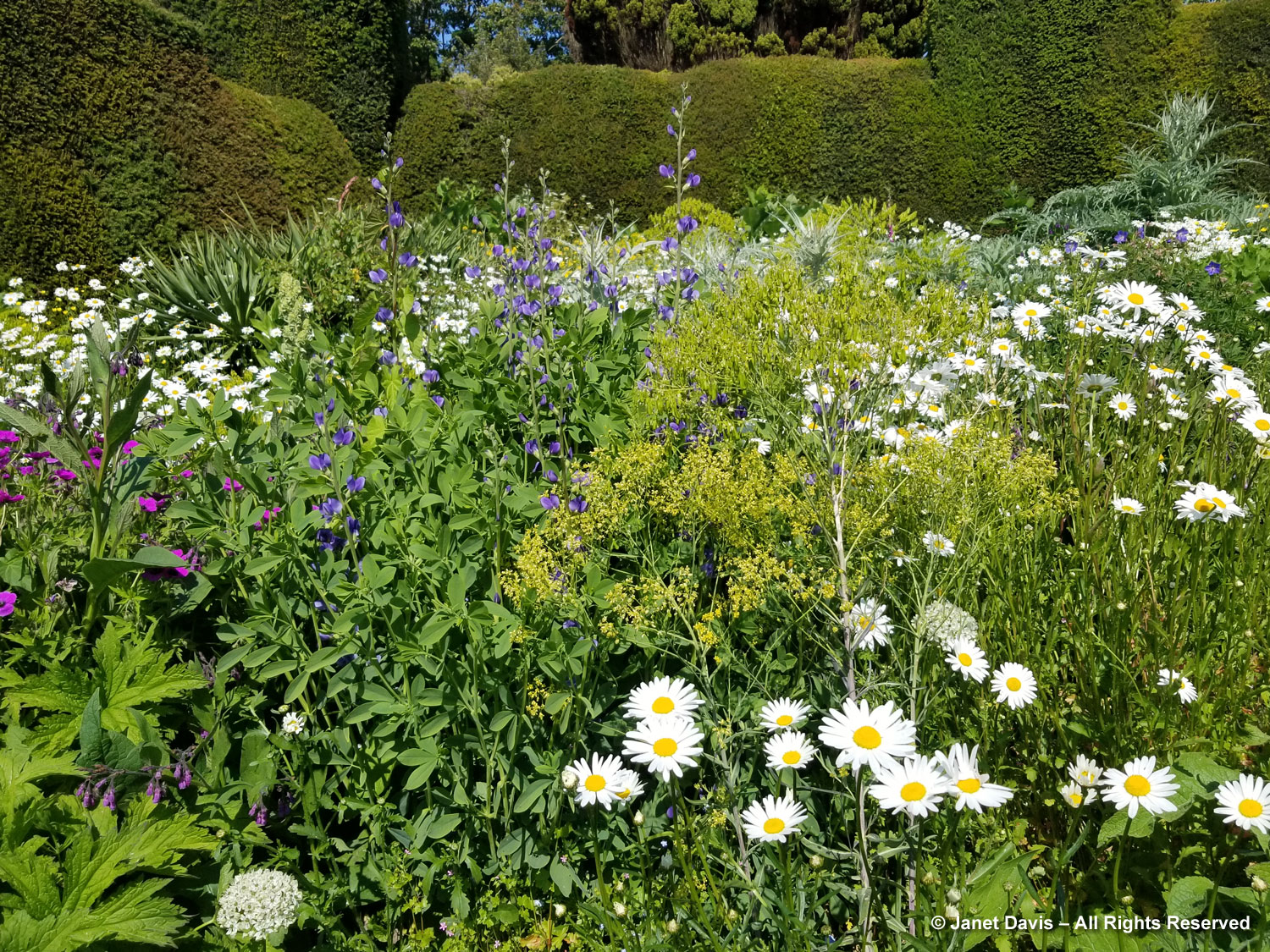
Finally I arrived at Great Dixter’s crown jewel, the Long Border. One of the original gardens conceived by Christopher Lloyd’s mother Daisy and maintained by her staff of 9 gardeners …..
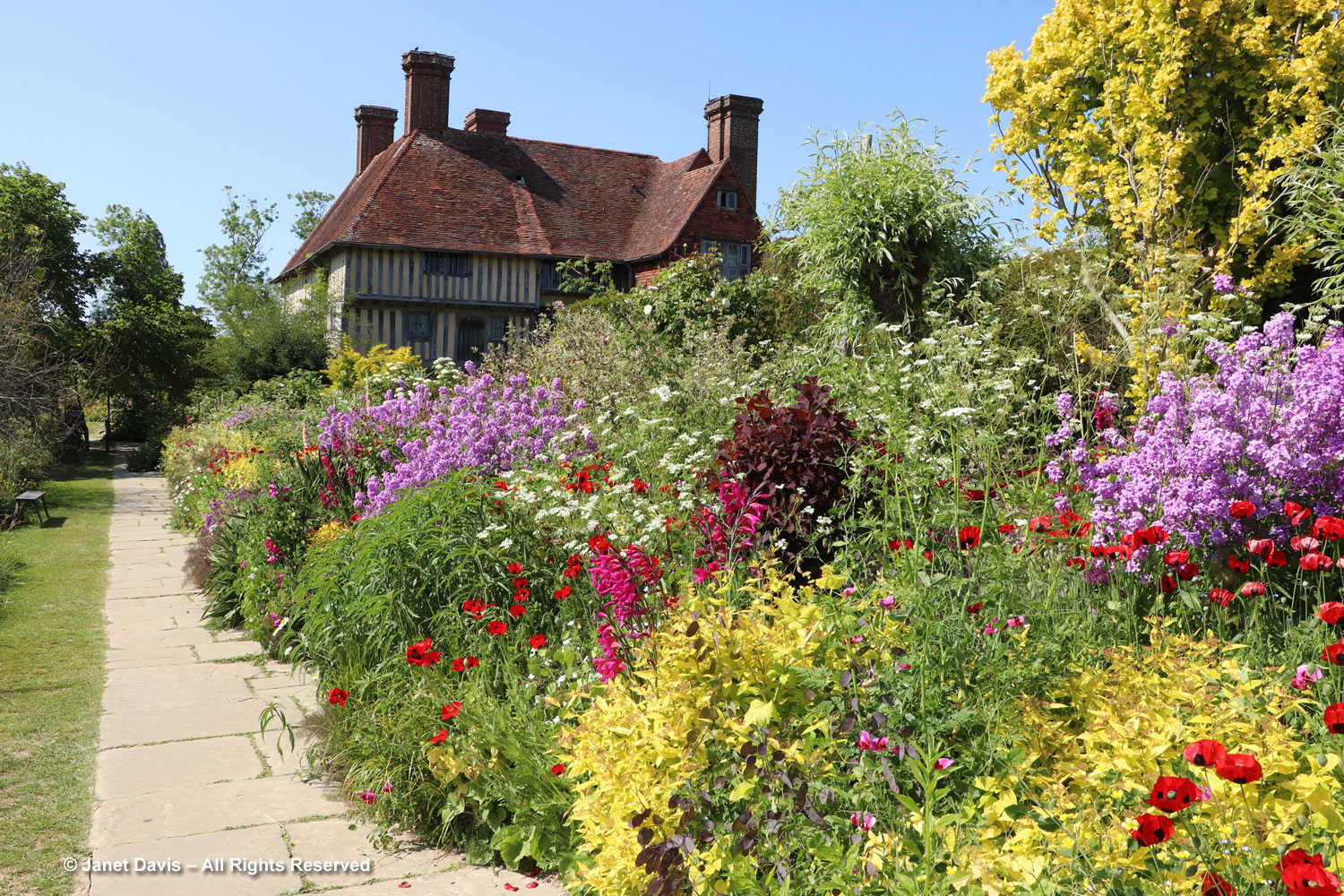
…. there is a photo of her standing beside it in 1917 with her dog, below, four years before Christo’s birth, the youngest of her six children.
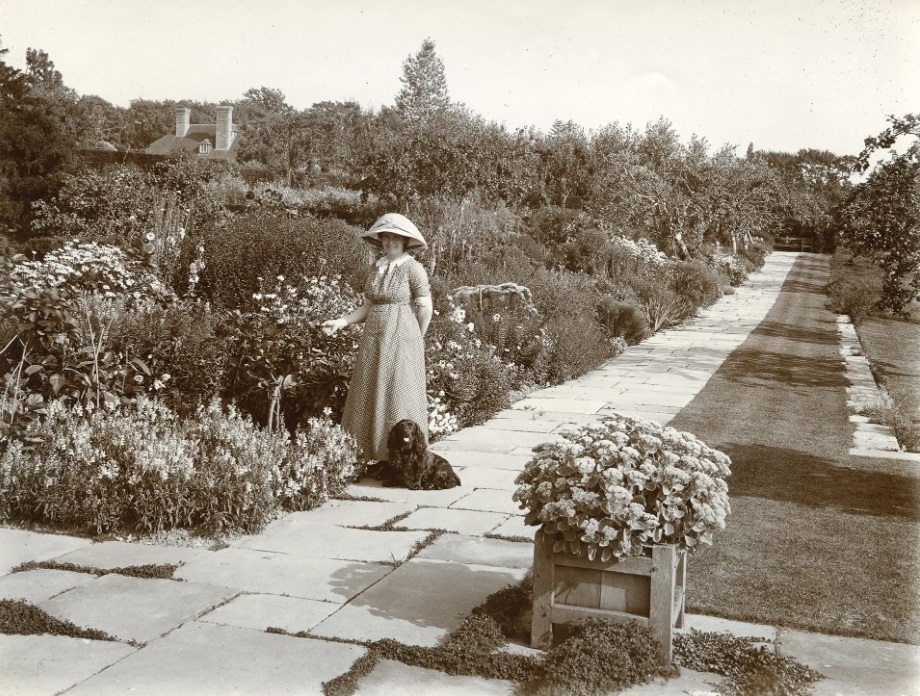
Fergus Garrett has described gardening at Dixter as “high octane”, and nowhere is that term more apt than in this border, which stretches 330 feet long (100 metres) and 15 feet deep (4.5 metres). Here are many of the plants seen elsewhere in the garden, but somehow exhibiting a more formal presence when arrayed in front of the clipped hedges. Like all the gardens here, the Long Border uses succession planting, taking advantage of the students and international ‘scholars’ who launch their careers here, to lift plants that are past their season and replace them with annuals and biennials. Or, as Fergus has said of this process, “high input, high output”. Self-seeding is encouraged, but monitored closely.
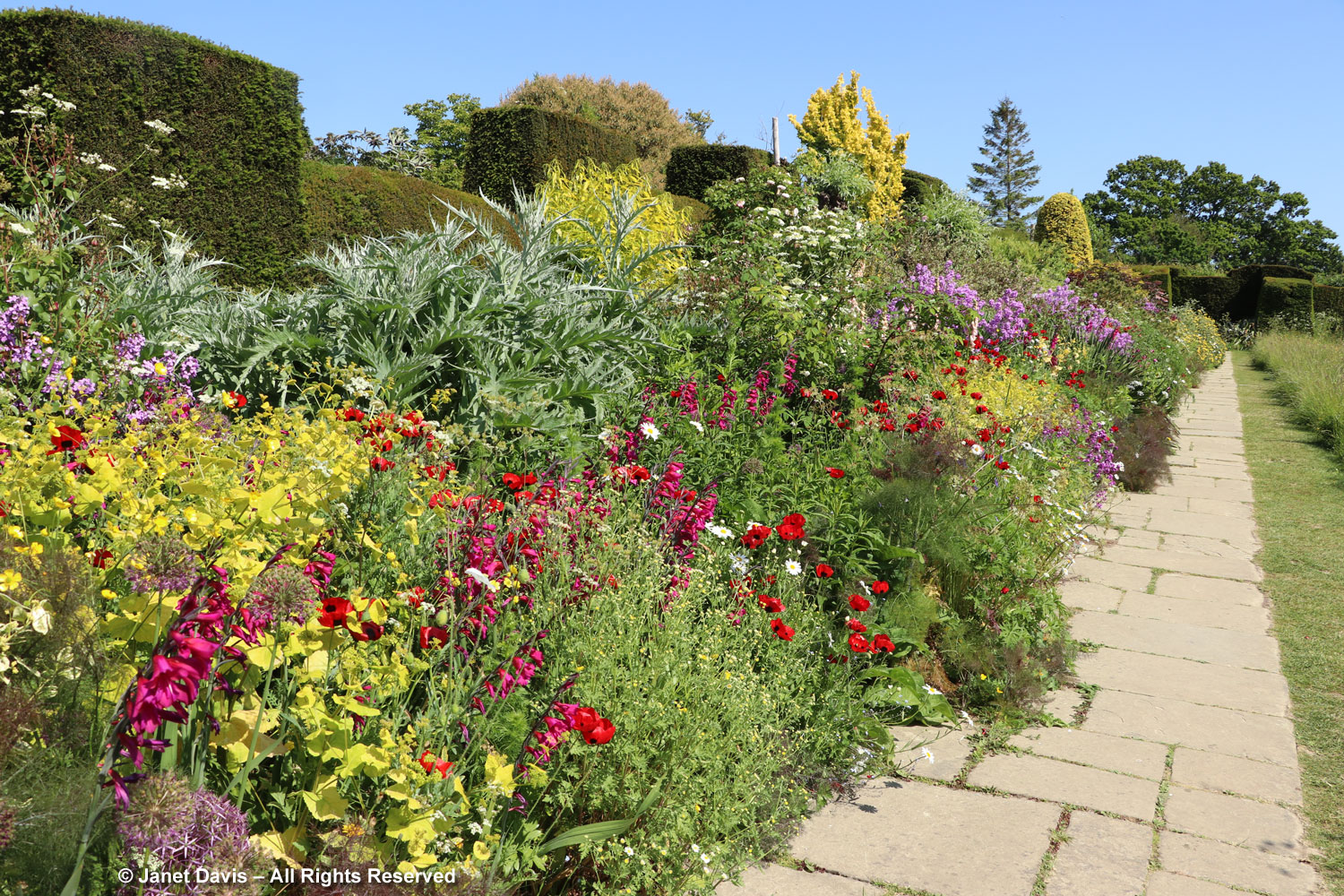
“Boldly go”. I borrowed this blog’s title from Star Trek but it applies equally to the colours at Great Dixter. Christopher Lloyd loved the bold and brash and was dismissive of the “good taste club”; I like that unafraid, idiosyncratic approach to gardening.
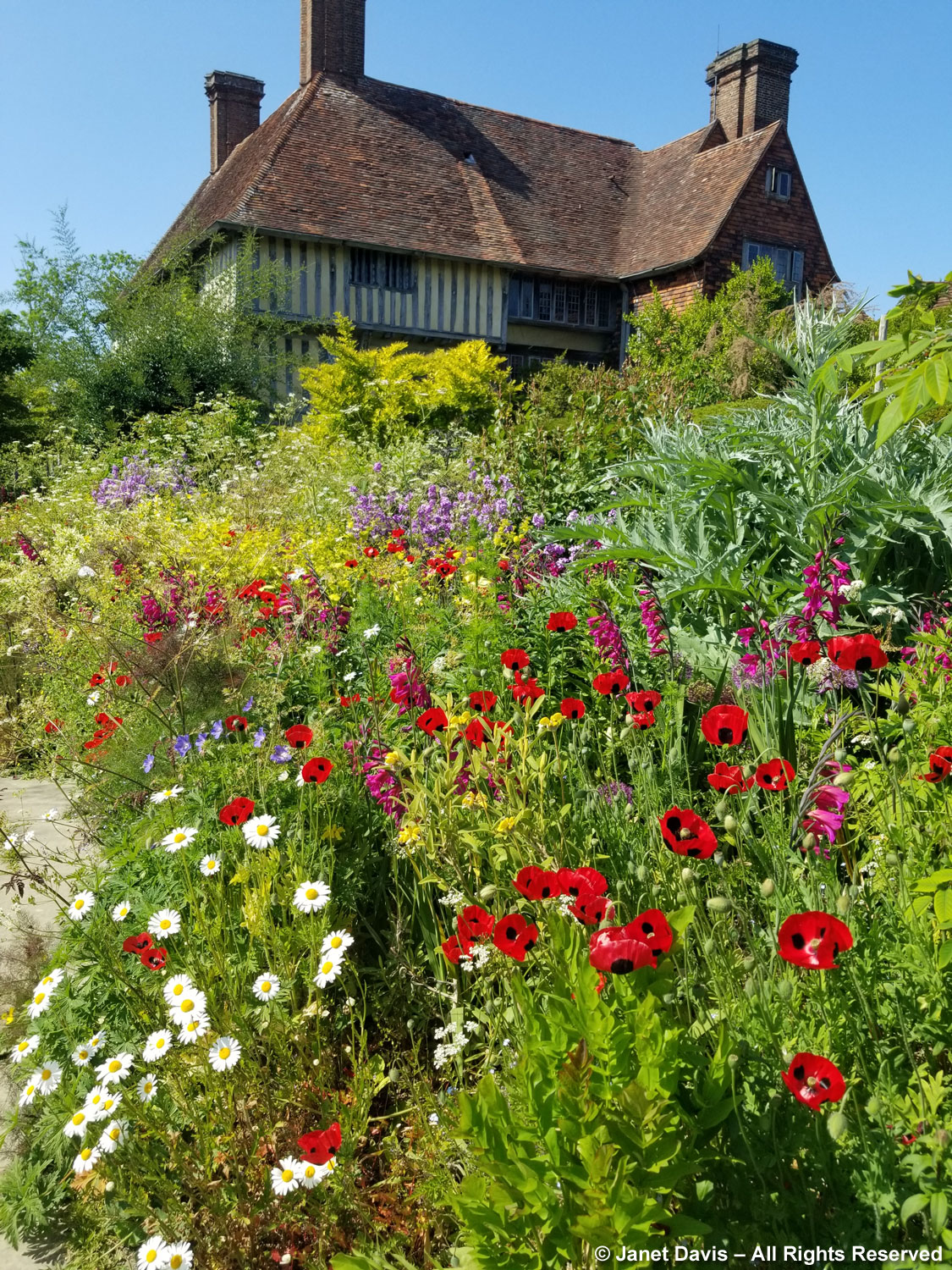
He wrote about the ladybird poppy, Papaver commutatum, in his book “Color for Adventurous Gardeners”, which is on my bookshelf, recommending it be planted under the white burnet Sanguisorba tenuifolia ‘Alba’. I think he would be just as thrilled to see it consorting boldly with yellow alexanders, below.
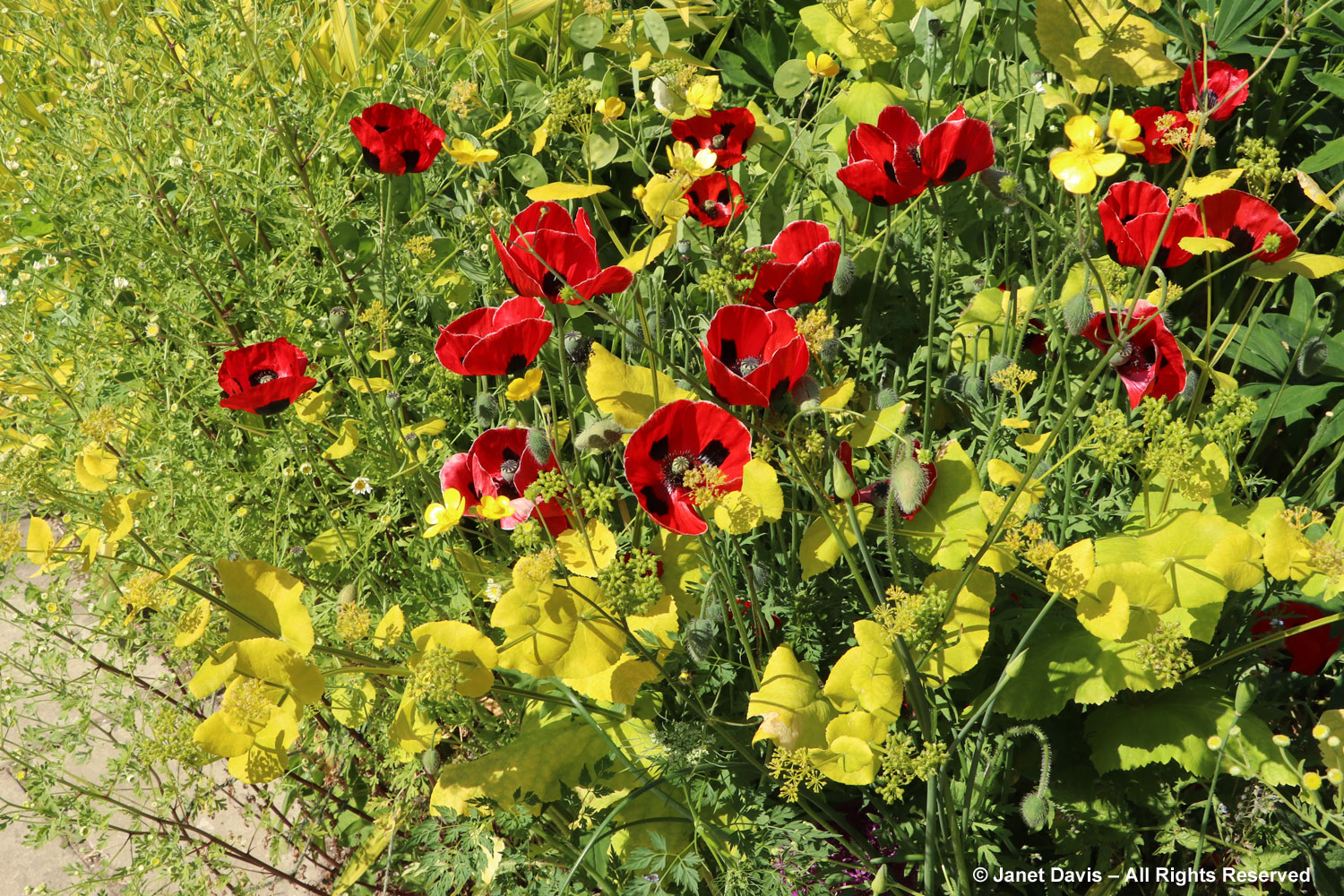
The foxgloves, below, are Digitalis purpurea ‘Sutton’s Apricot’. Seeds of this biennial are sold in glassine packages in Great Dixter’s shop.
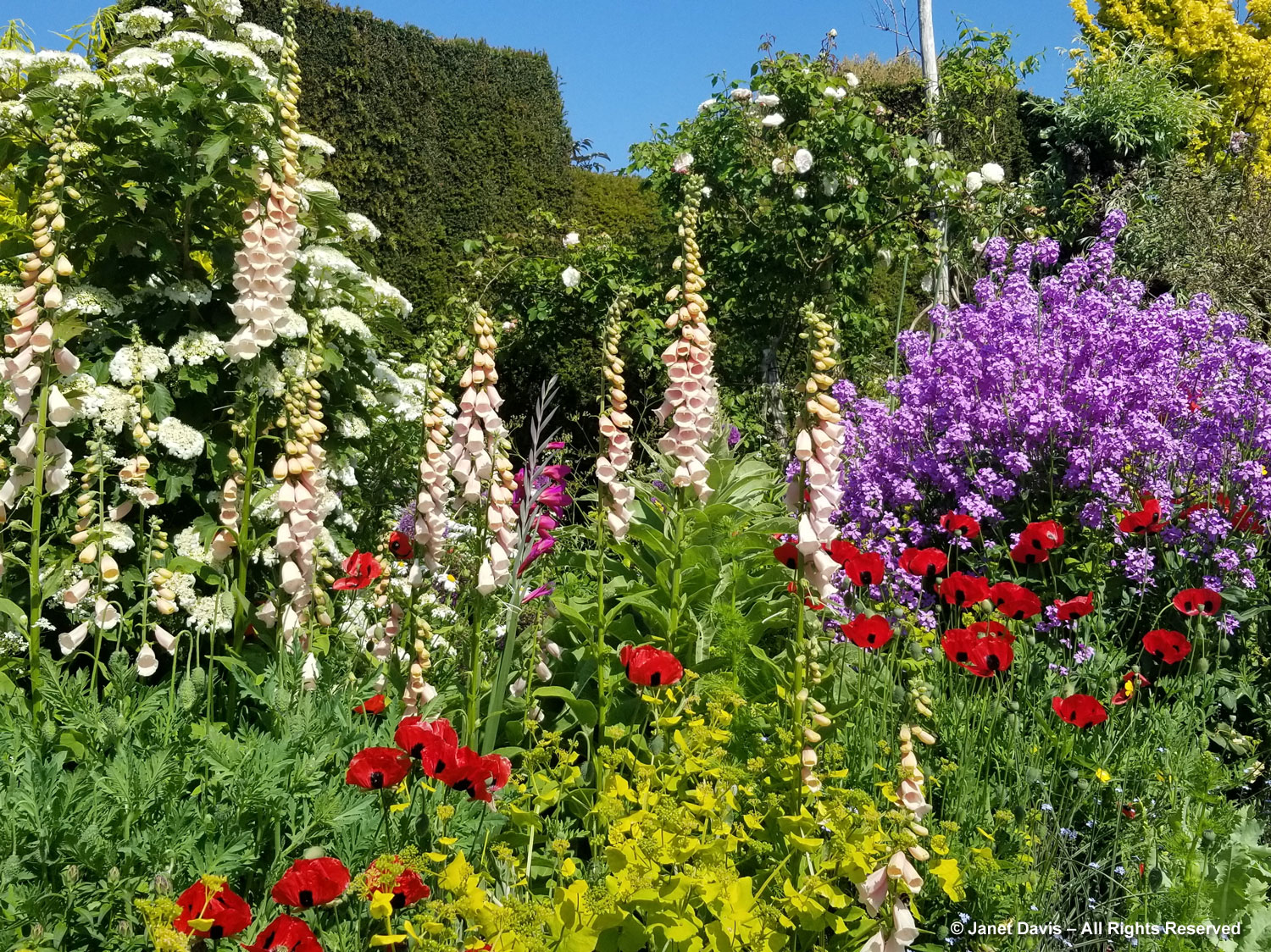
I found a bit of shade in the Long Border and you can see how much better the plants look without the harsh contrast of full afternoon sun.
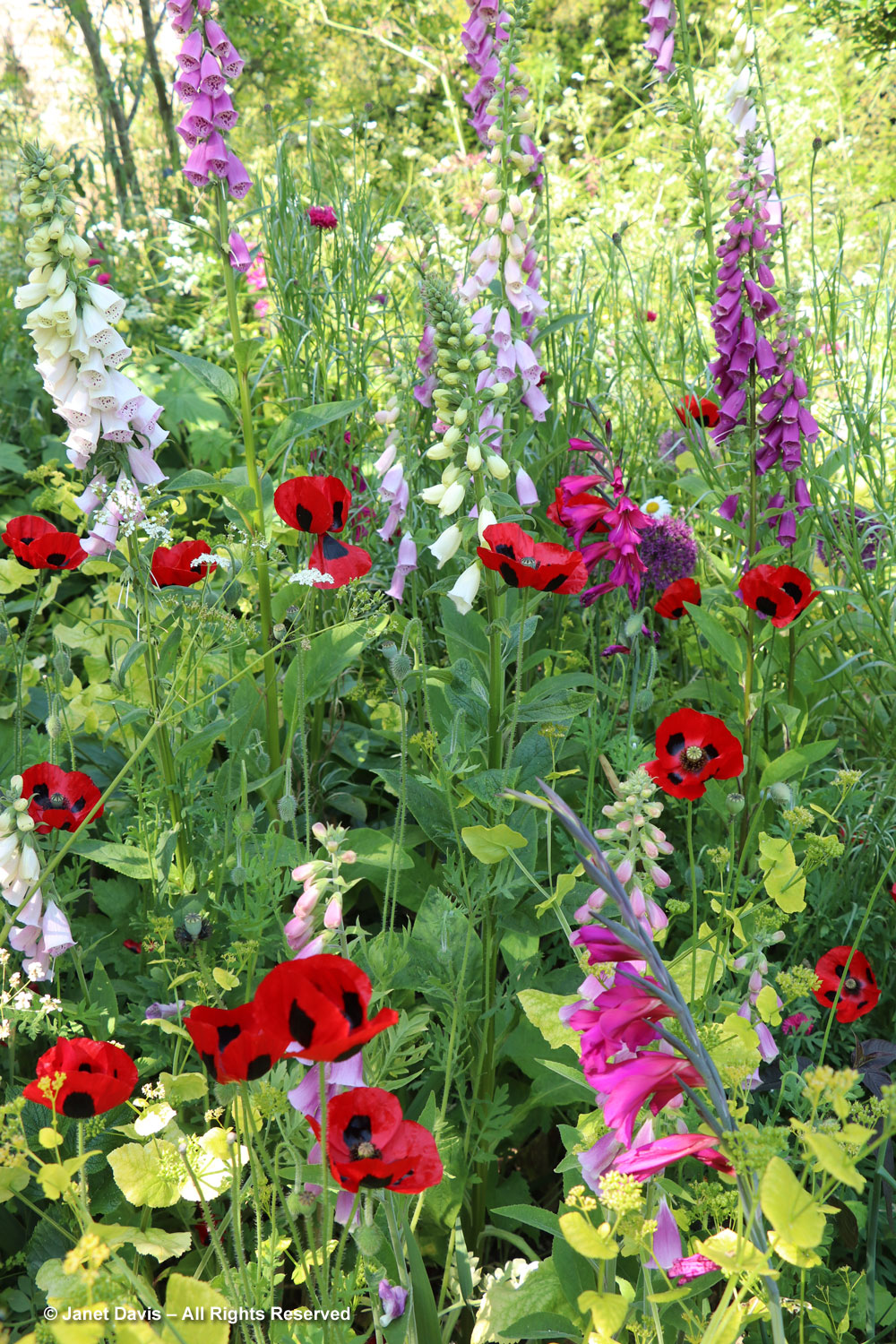
Yellow Jerusalem sage (Phlomis fruticosa) is used extensively in the Long Border, and plants are sold in the shop. The white allium is A. nigrum.
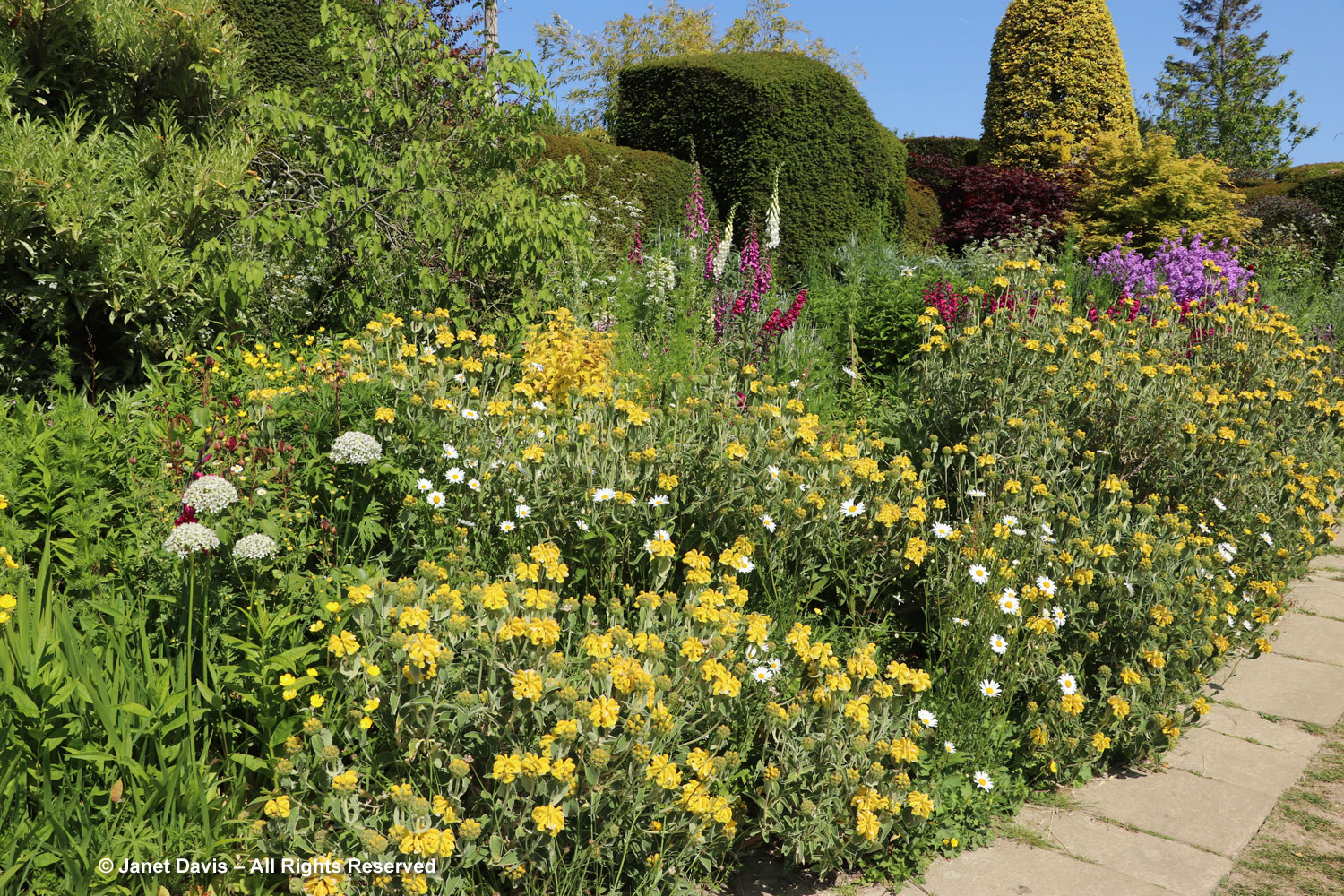
There were textural bits of shade in the Long Border that caught my eye, like the sensitive fern (Onoclea sensibilis) and euphorbia, below.
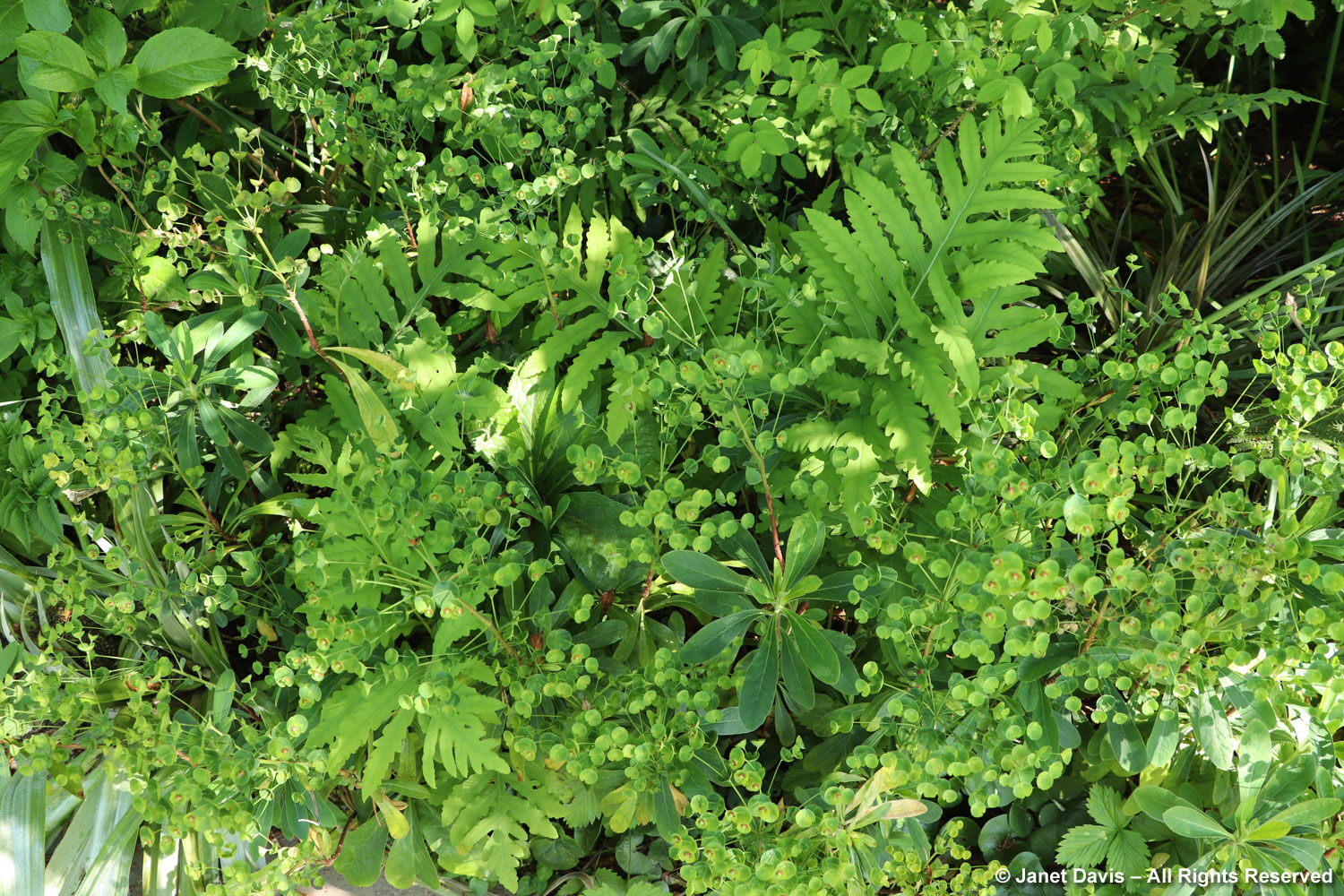
I love these green vignettes, with little pinpricks of colour.
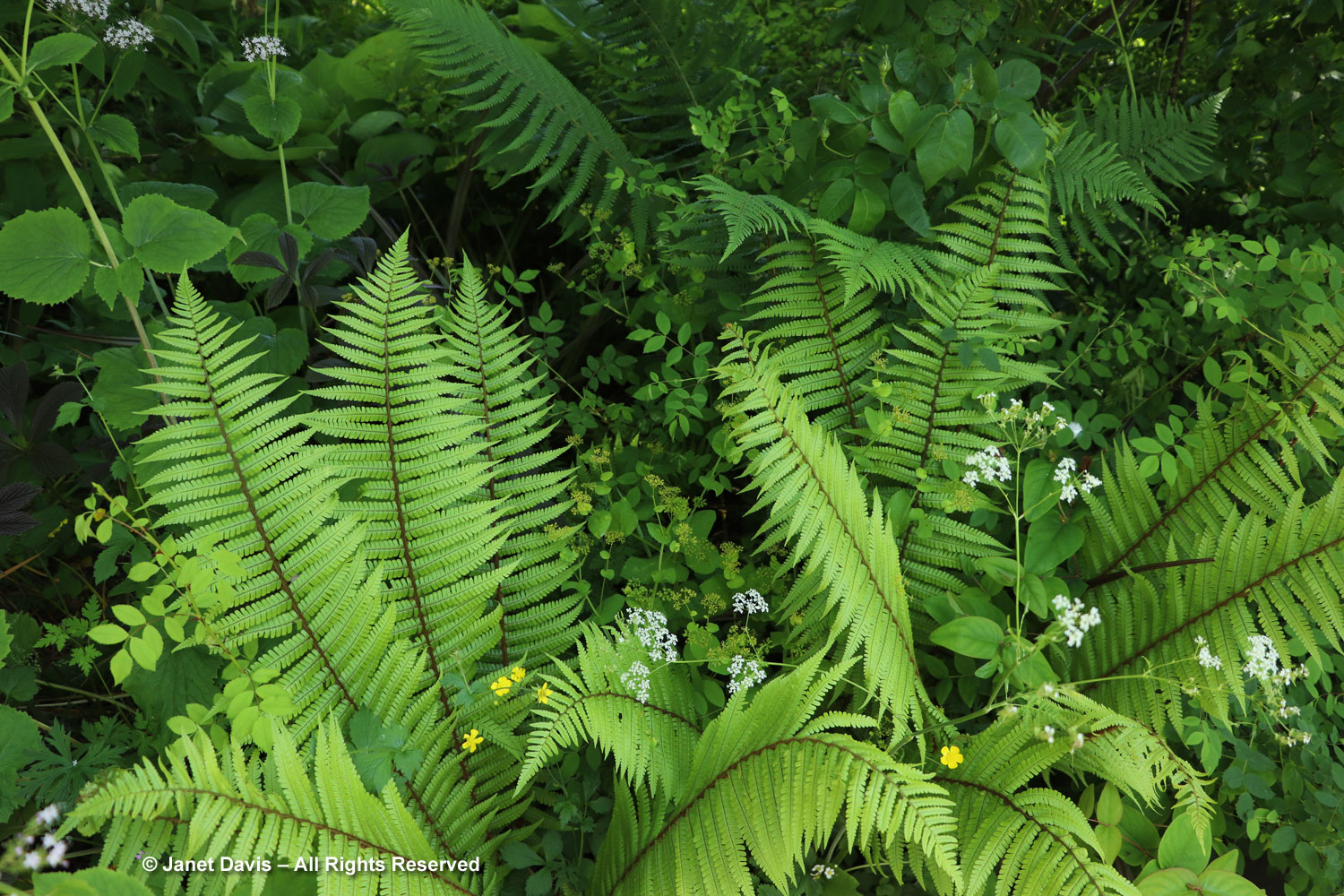
Then there are the meadows. There is a striking contrast between the Arts and Crafts formality of the sculpted yews in the Topiary Lawn – once used as a practice golf-putting range by Nathaniel Lloyd – and the orchid-rich meadow in which they stand. As noted in the book Meadows at Great Dixter and Beyond by Christopher Lloyd, re-issued in 2016 with an introduction by Fergus Garrett, the Topiary lawn is one of “a dozen different meadow habitats” at Dixter, providing a high degree of biodiversity.
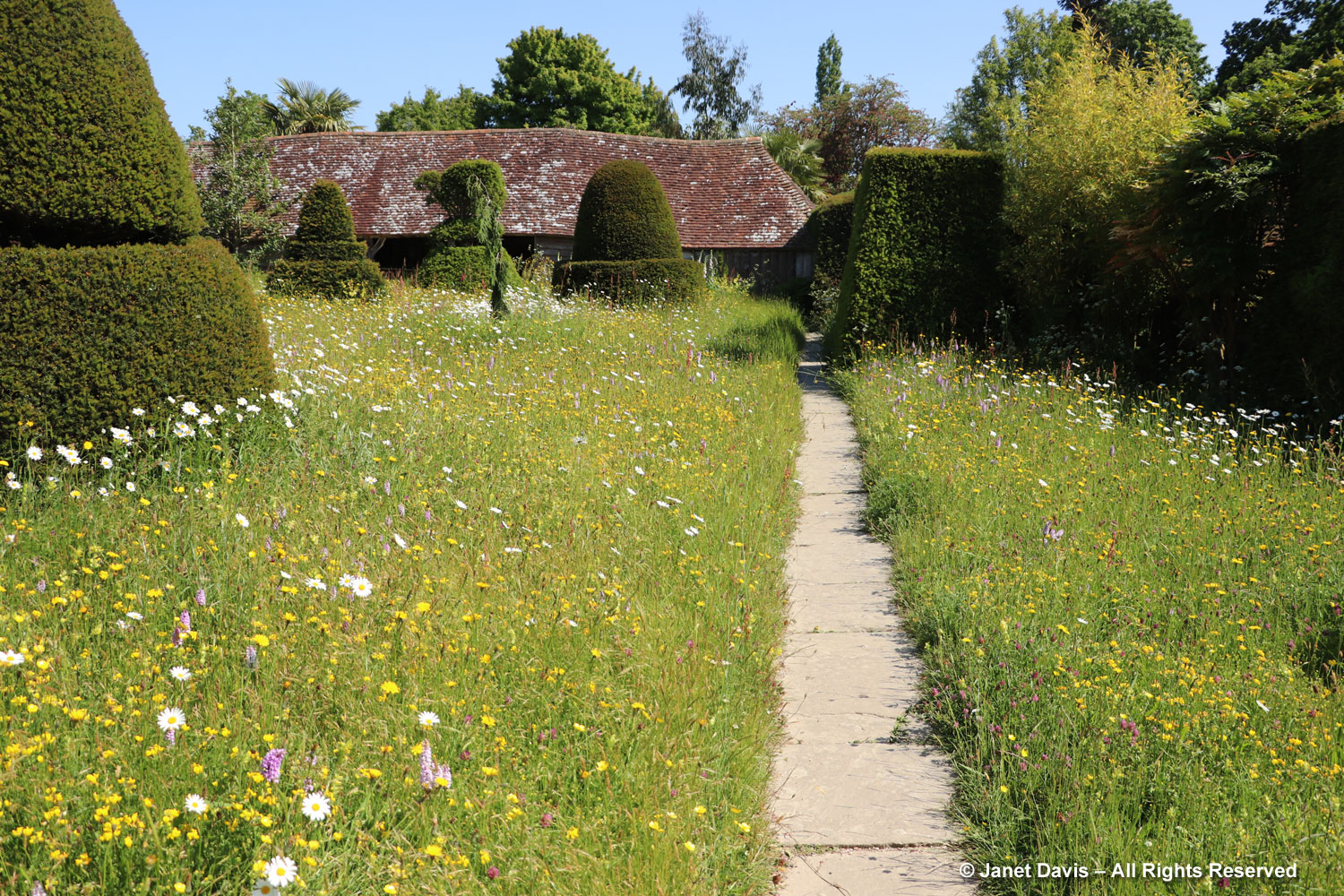
It was Daisy Lloyd who introduced the first meadows to Great Dixter and to her youngest son Christopher, below, the only one of her six children who shared her passion for gardening. He was a boy when the Lloyds took him to Munstead Wood to visit Gertrude Jekyll, who wrote later to say she hoped he’d grow up to be a great gardener. He was just 12 when his father died in 1933, at which time Daisy assumed management of the estate, in time helped by Christopher. She died in 1972 at age 91.
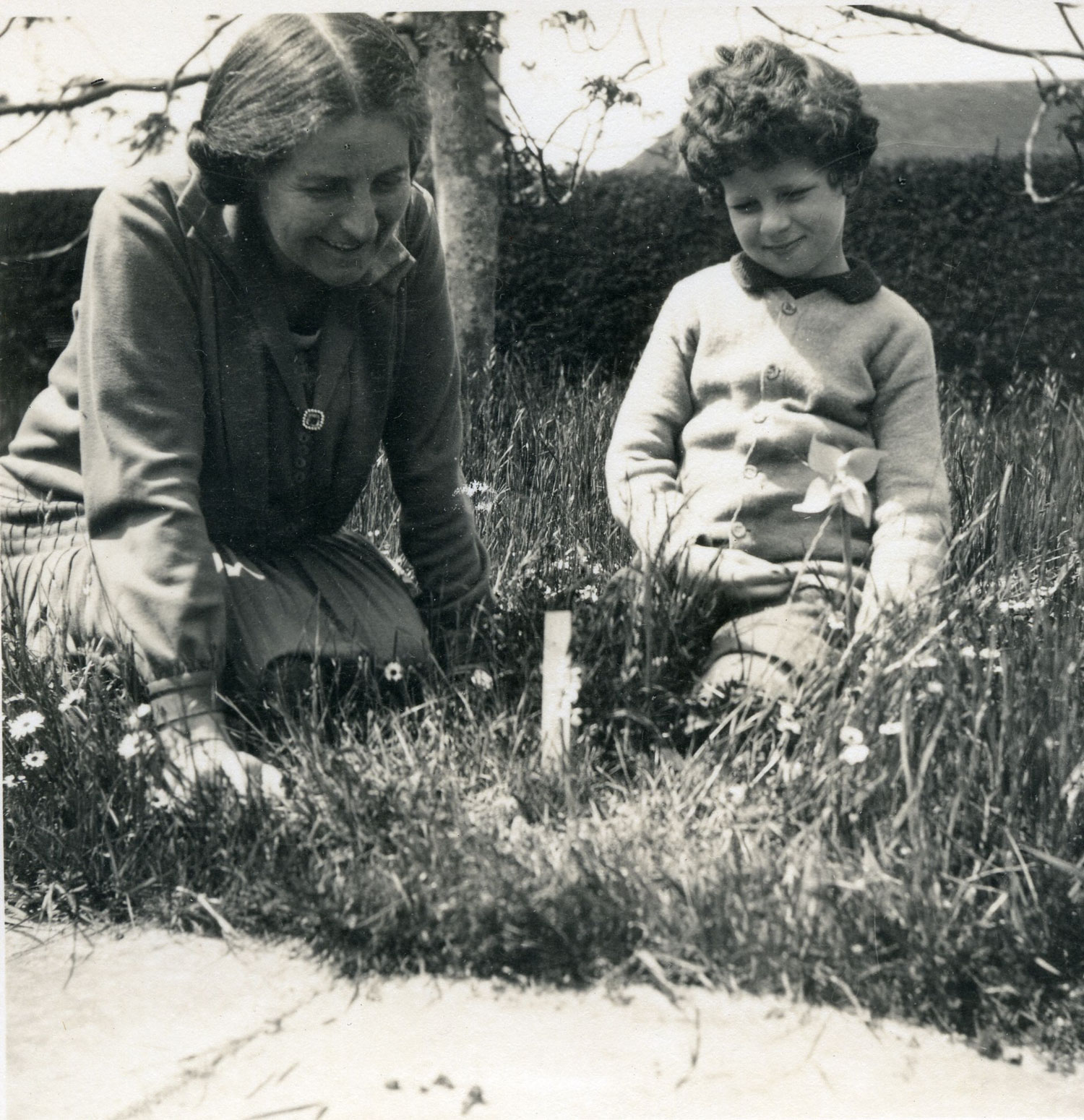
When I was in the Topiary Lawn in early June, there were oxeye daisies (Leucanthemum vulgare); buttercups (Ranunculus repens); clover; a yellow, dandelion-like composite (possibly Hypochaeris radicata); mauve-pink common spotted orchid (Dactylorhiza fuchsia); and yellow rattle (Rhinanthus minor). Earlier in spring, the meadows feature various species narcissus, snakeshead fritillary and camassia. Meadow-cutting is done in August and September, and the seed-rich hay is made available to locals to encourage them to reduce their lawns and embrace the great biodiversity of meadow gardening. Fergus Garrett also gives lectures to help gardeners in the meadow-making process.and his good friend, designer and writer Dan Pearson has been gifted meadow sweepings in exchange for lecturing at Dixter in the hope of introducing orchids to the meadows at Hillside, his Somerset garden.
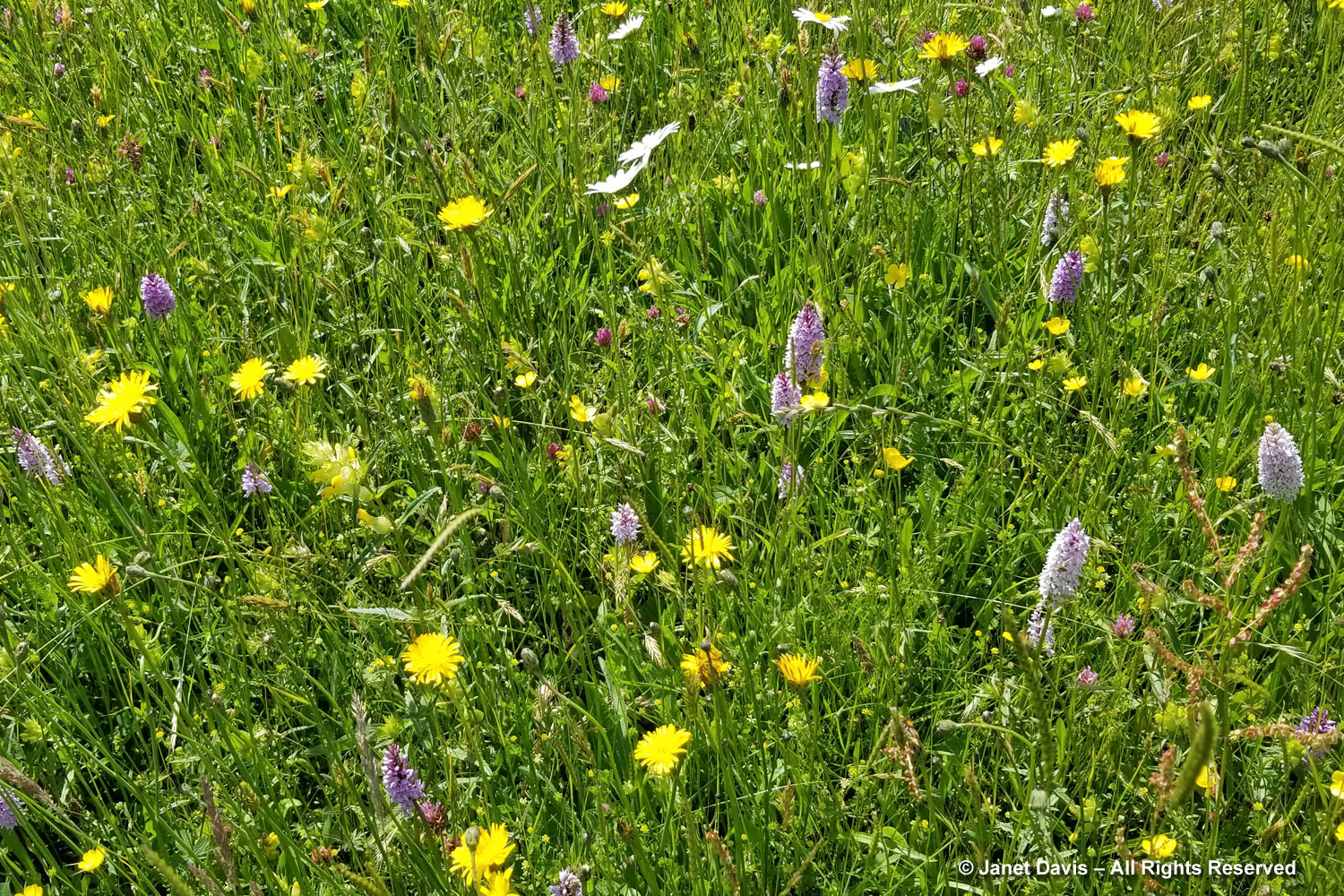
Common spotted orchid is one of four orchid species to thrive at Great Dixter. The others are early purple (Orchis mascula), green-winged (Anacamptis morio) and twayblade (Neottia ovata).
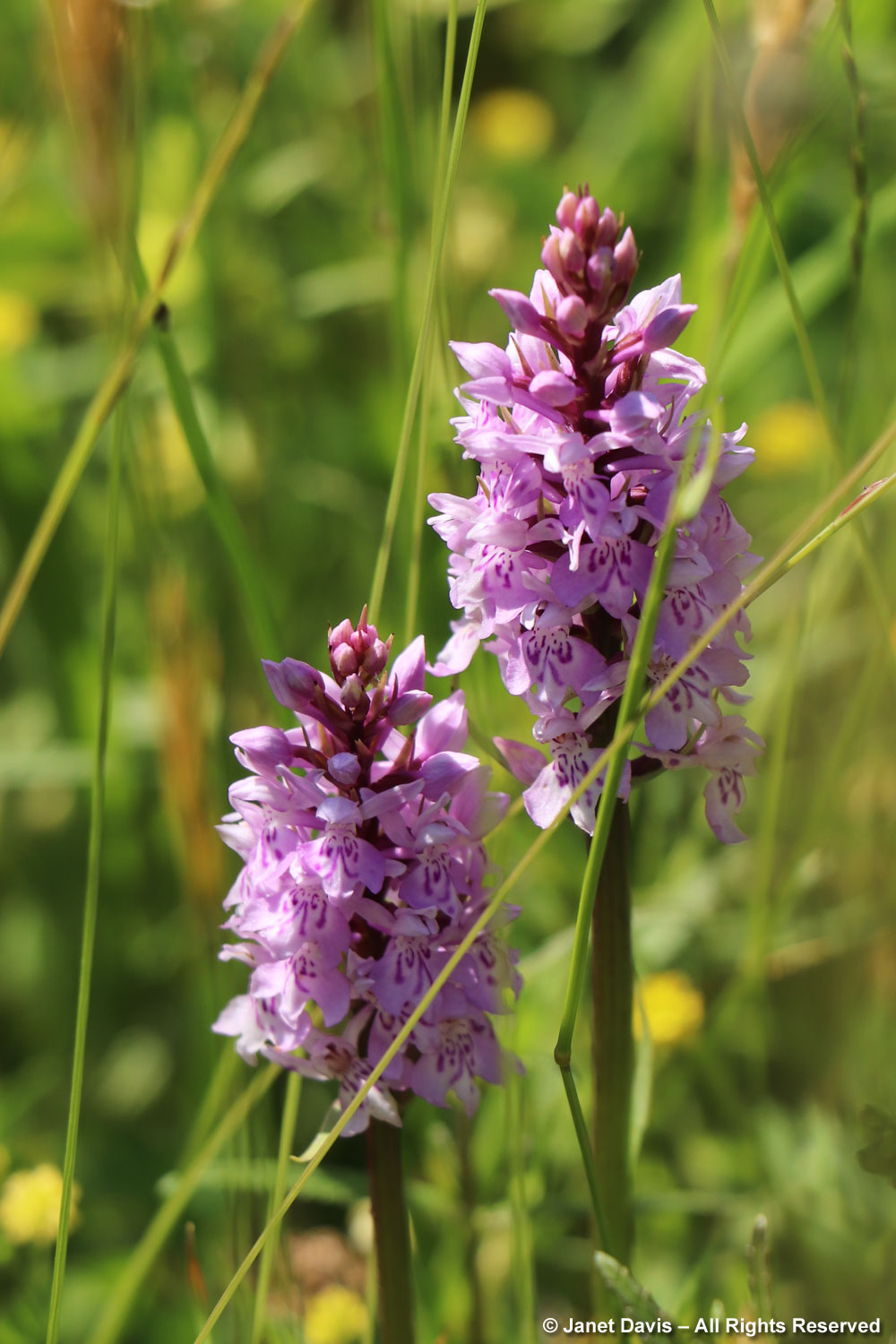
Annual yellow rattle, aka hay rattle, is semi-parasitic to grasses, reducing their competition and enabling the orchids and other wildflowers to gain a stronger foothold.
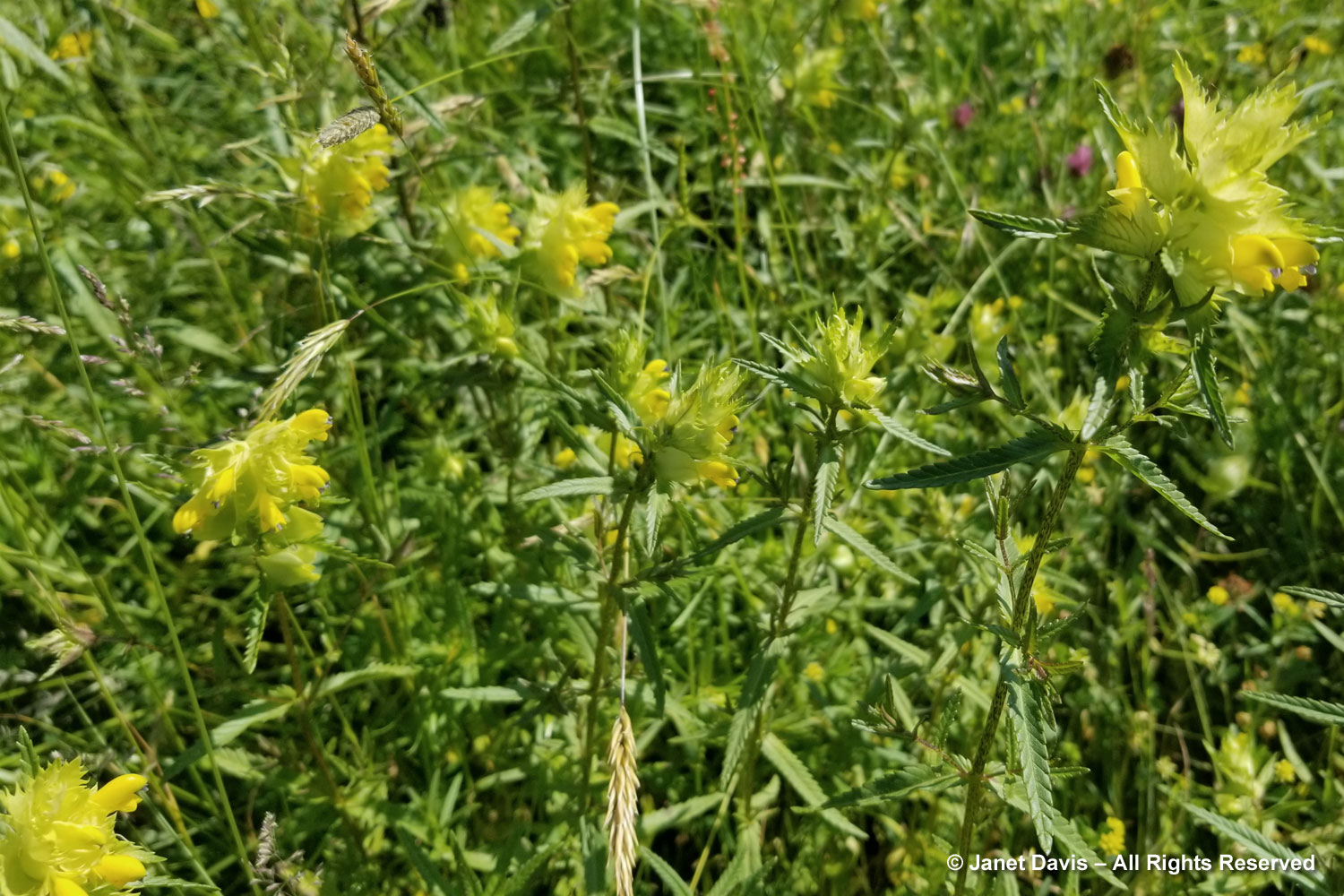
Much has been written about the great biodiversity at Great Dixter. As Fergus Garrett writes in this Gardens Illustrated article, “Archaeologists, naturalists, ecologists, botanists and entomologists were commissioned to carry out the survey dividing the Great Dixter Estate into different zones such as the woodlands, pasture and meadows, formal ornamental gardens, ponds, and the Plant Fair Field. Each zone was surveyed and the findings fed to one principal ecologist who analysed and pulled the information together in a report. The results were astonishing. As expected, the wider estate with its ancient woodlands, pastures and meadows, and ponds was extremely rich. But, surprisingly the richest part of all was the ornamental garden.”
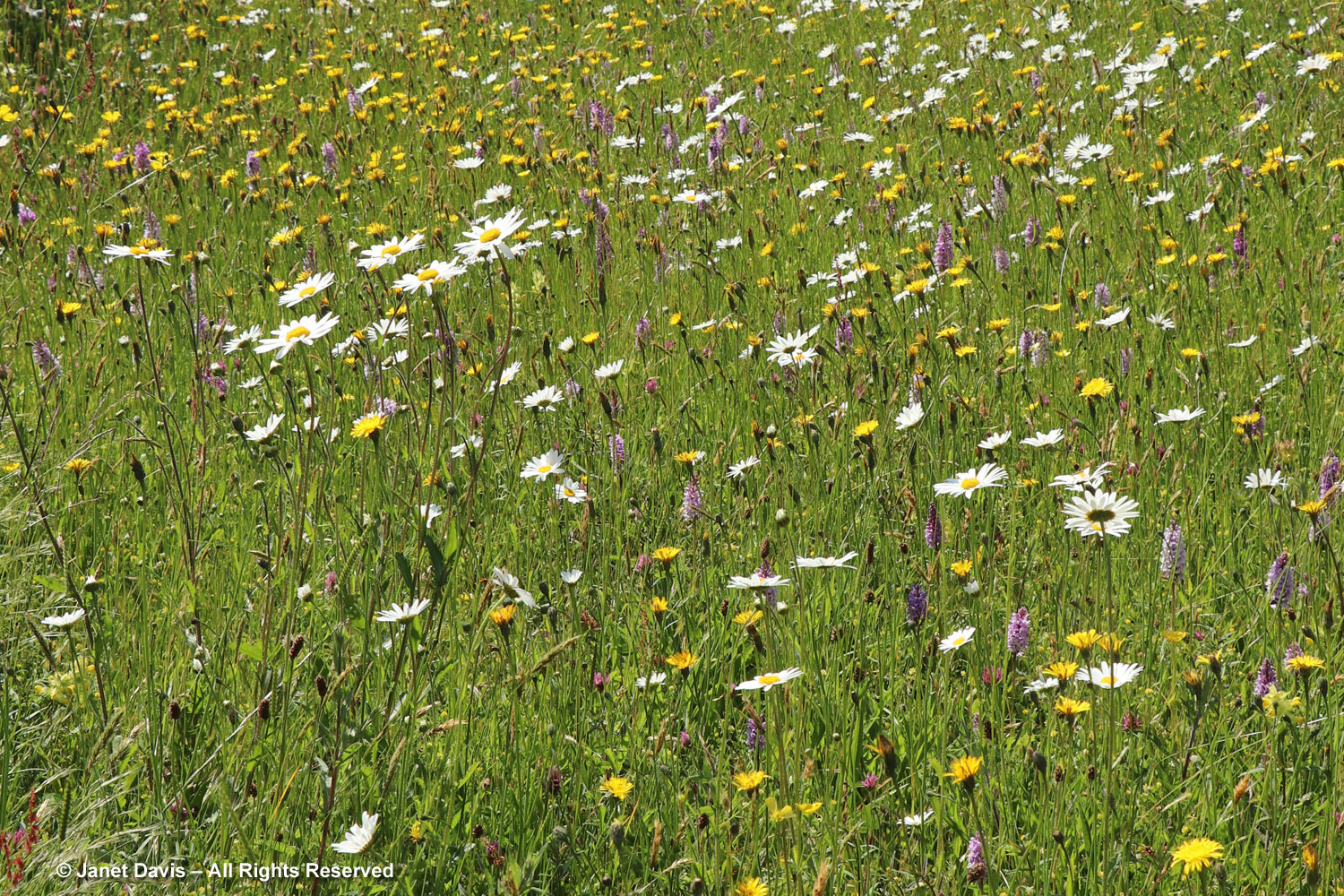
In longer grass, meadow cranesbill (Geranium pretense) and Byzantine gladiolus (G. communis subsp. byzantinus) thrive.
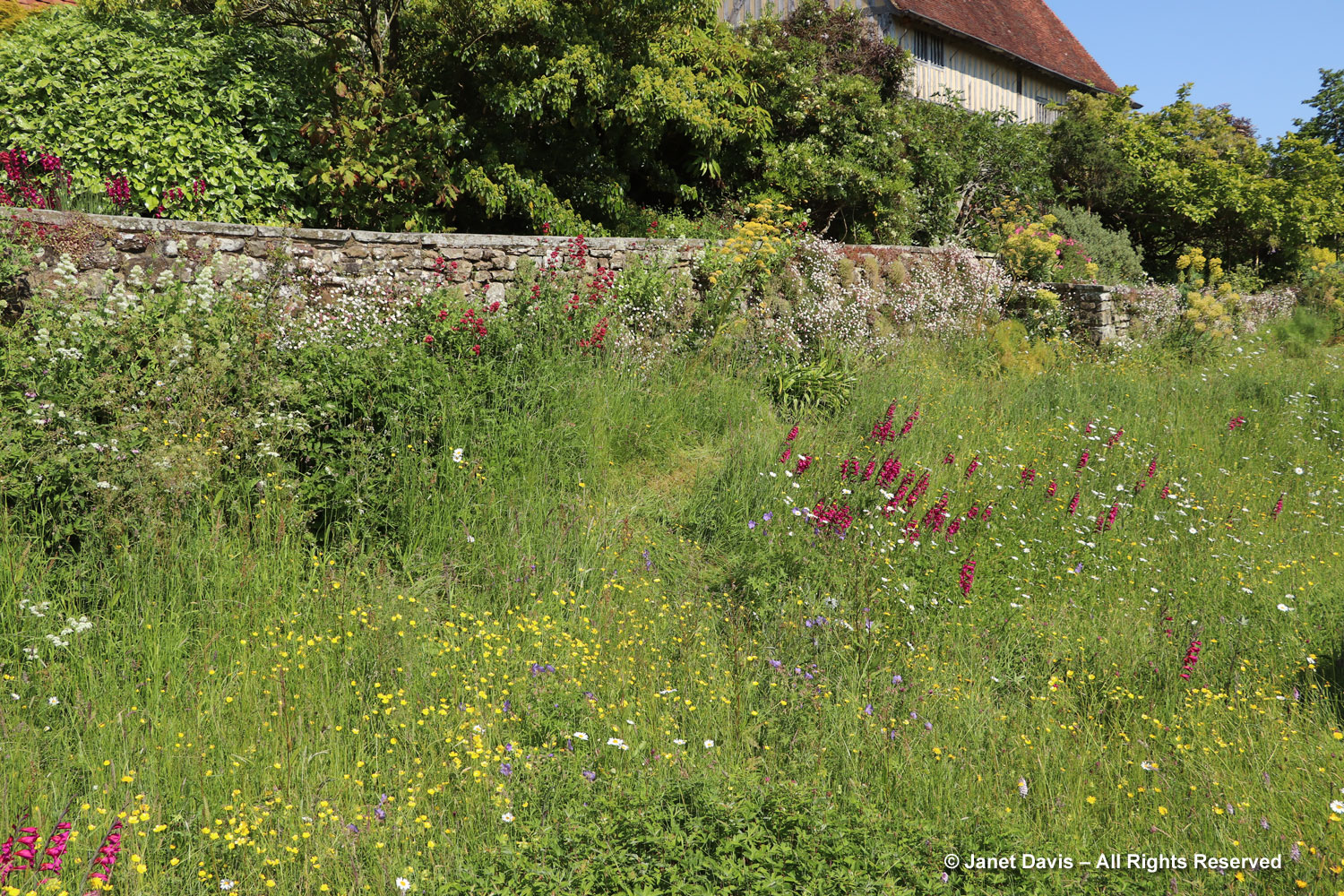
Christopher Lloyd was very fond of this rich-magenta gladiolus (which is sadly often sold as the paler, shorter G. italicus) and wrote in his book Garden Flowers (2000): “The gladiolus which most endears itself to me is the prolific G. communis subsp. byzantinus, long known as G. byzantinus… It tucks into many border positions where it will not get in the way after flowering, for example up against a group of border phloxes . . . . Another use of it I fancy is in a meadow community, where it holds its own well.”
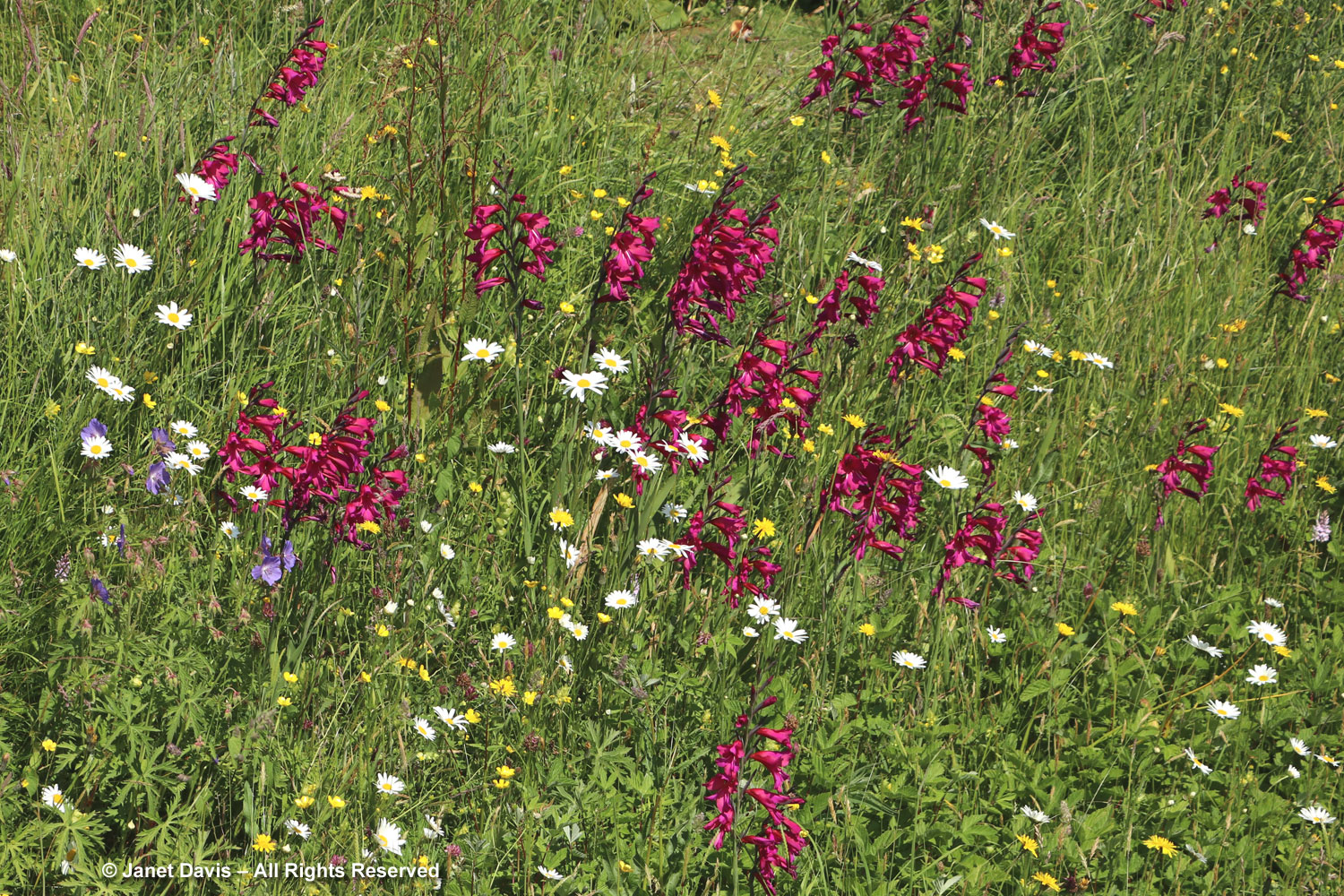
****
And that brings me to Christopher Lloyd. Gardens are about people, of course, and Great Dixter, like nearby Sissinghurst, is known for its larger-than-life founding personality. Though I was never introduced to Christo, I did sit beside him in October 1989 at the Third Great Gardening Conference at the Civic Garden Centre in Toronto (now the Toronto Botanical Garden). He was due to speak at the conference, along with his dear friend Beth Chatto, but jet lag being what it is he nodded off a few times and I gazed fondly at the top of his silvery head bent beside me. Below is the advertisement for that event. Three years later, I visited Great Dixter but he was away on that May 1992 day.
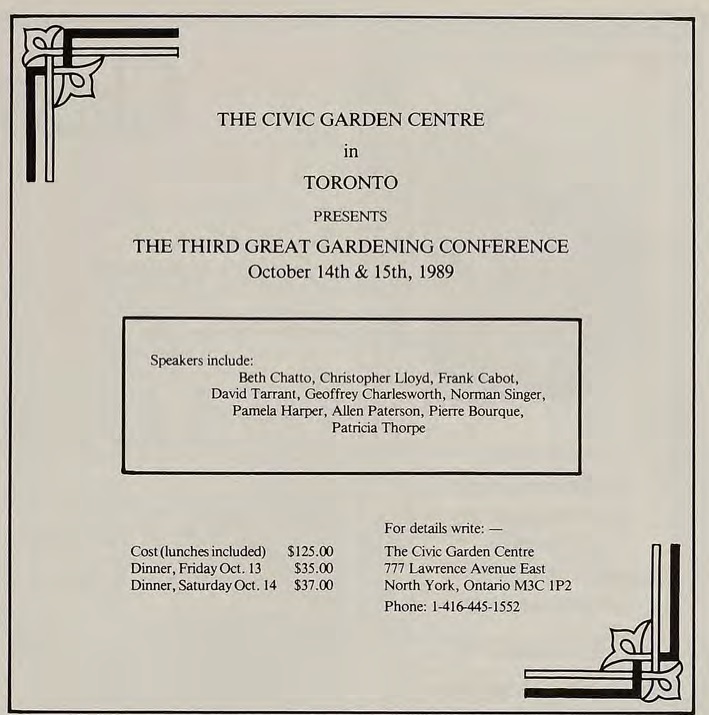
You get a good sense of his crusty personality in this lovely memorial video by Allan Titchmarsh, produced in 2006:
It was during a 2001 lecture tour to North America marking his 80th birthday that Christopher and Fergus were hosted in Toronto by my friends, Geoffrey and Susan Dyer, both passionate gardeners. At the time, Geoffrey was on the board of the Civic Garden Centre, soon to be the Toronto Botanical Garden, and it was in their home that the seed of a possible future for Great Dixter was sown. As Geoffrey recalls: “We were having a drink in the evening and I just asked them quite casually, what’s going to happen (to Dixter)? I didn’t know the particulars of the ownership arrangement… but I knew he didn’t have a spouse and he didn’t have heirs… and the consequence of inheritance tax in the UK and that kind of thing is something people have to plan for.” When Cristopher replied that his accountant had been pressing him about future plans, Geoffrey said: “I’m not qualified in the UK but I’ve worked around that area fairly extensively in my law practice, so if there’s anything I can try to help with, I’d be happy to do it.” In fact, Geoffrey’s Toronto-based law practice specializes in estate and taxation law so he was the perfect person to pose questions to his guests about succession. That summer, the Dyers were invited to stay at Great Dixter where the first meetings to establish the Great Dixter Charitable Trust (GDCT) took place. Twenty-two years after that drink with Christopher Lloyd and Fergus Garrett, Geoffrey Dyer remains the Chairman of the GDCT, and writes the charity’s annual Review of the Year.

I last saw Fergus Garrett at an April 2018 lecture he gave to a packed house at the Toronto Botanical Garden, below. Says Geoffrey Dyer: “The Christopher Lloyd legacy is alive and well, but Fergus is Dixter today. His energy, his charisma, his intelligence, his vision – it’s absolutely huge.”
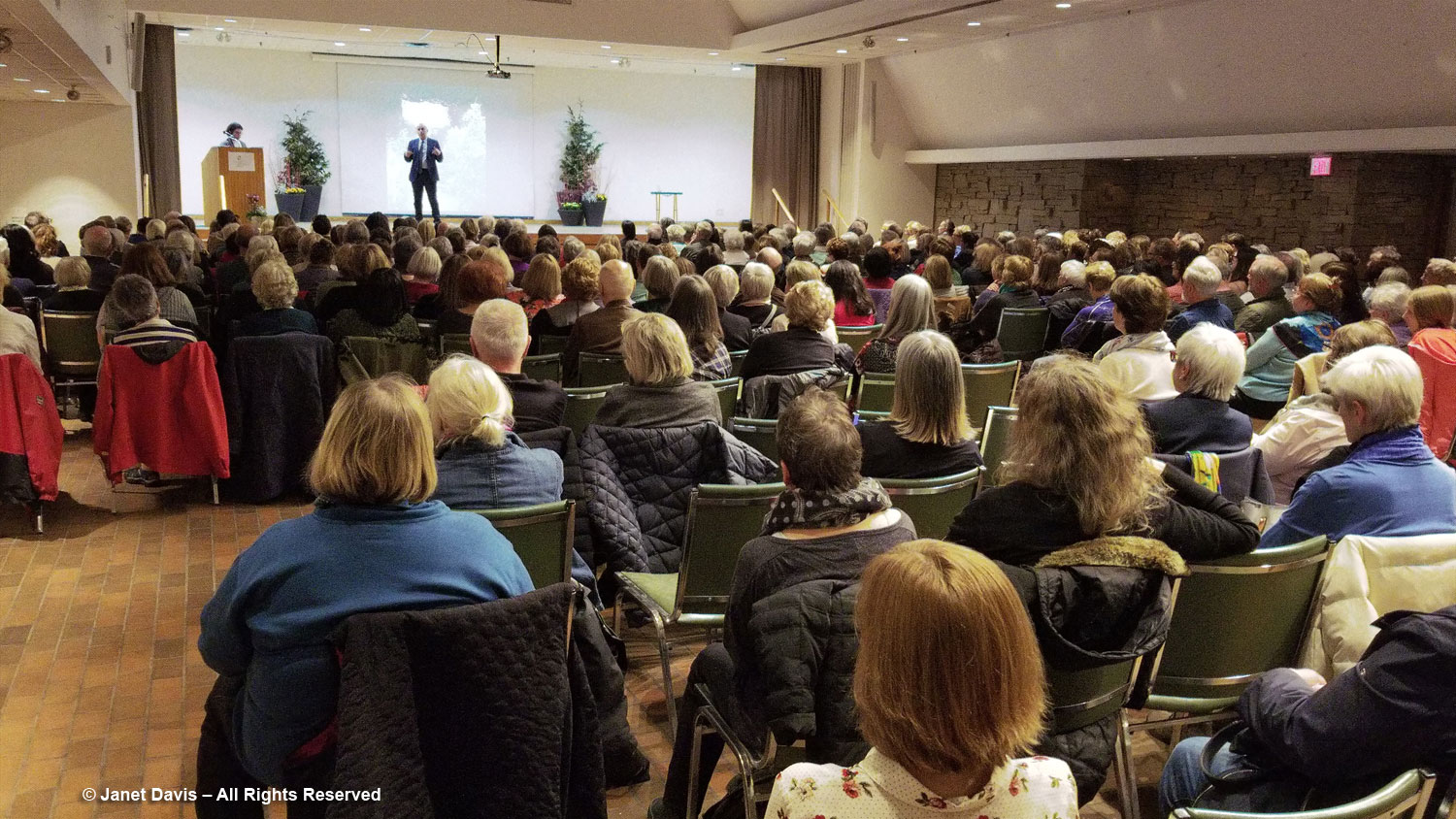
It was a pleasure to visit Great Dixter, to enjoy its bold plantings, and to reacquaint myself with the story of the people that have made it the great garden it remains today.

A terrific tour of Great Dixter. I might never get to see it in person but this makes up for it
I introduced David Tarrant at that incredible conference. And I was allowed to talk about weekend on the CBC. Can you imagine that today? I mean the conference.
We were very very lucky. And I imagine that Christo convinced me that orange in the garden (and anywhere) is a fabulous colour.
Well done you
Marjorie – Thank you. Weren’t they wonderful conferences? Geoffrey tipped his hat to Brian Bixley for organizing such stellar lineups in those halcyon days.
Is yellow alexanders a different plant than golden alexanders (Zizia aurea)? In your photo the flower looks the same but the yellow alexanders seems to have a golden leaf that Zizia doesn’t have. Or perhaps it’s two different plants intermingled?
Hi Kathy – yes, they’re different “alexanders”. This is yellow alexander, Smyrnium perfoliatum, a chartreuse-leaved biennial. I do grow golden alexanders, Zizia aurea here at the cottage, a good perennial.
Wonderful, Janet!
Another fine accounting of gardens, plants and people – well documented with your photos.
I must say that I miss you and your posts and wit on FB. Hope you are well.
Best to you. Mike Bush
Thank you Mike! I made a new page on FB so look me up! I missed all my old friends.